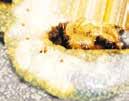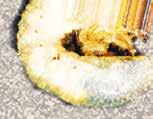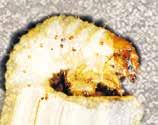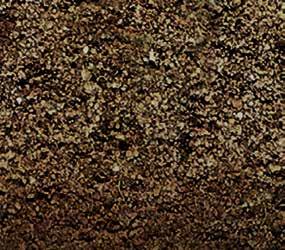




























As the magazine is published, so comes the important news of full approval for Acelepryn. The timely announcement now gives turf managers a firm weapon in the armoury to help control the threat of grub damage.

We get the full statement from Syngenta on page 8, plus a comprehensive guide to IPM for these soil-dwelling pests which involves: identification of the pest, establishment of action thresholds and treatment priorities, monitoring and appropriate action. Undertaking these steps will help to reduce the threat of damage caused by chafer grubs and leatherjackets.
In other industry news, a number of Associations including the FA, SAPCA and England Rugby, have recently released a joint statement relating to the environmental sustainability of artificial grass pitches and the use of rubber crumb in 3G pitches (read more on page 6). For years, Pitchcare has been lobbying for a better understanding and potential ban on the use of rubber infill and the recent statement affirms our findings and concerns over the years. I hope that the statement brings forward quick action for clarity and safety on all pitches across the country.
This issue is packed with topical, informative content including an insightful look into British manufacturing and the impact of Brexit, the pandemic and global logistics. I spoke to a selection of British manufacturers (page 30) to discover what all that means for turfcare innovation.
We also have our regular Top Tips - this issue covering BASIS FACTS qualifiication (page 16) and the benefits of this Certificate of Competence in Fertiliser Advice. Plus, James Matthewman analyses three varieties of seed; fescue, bent and ryegrass to explore which one is best in different climates and applications (page 70). Also, our weather expert Mark Hunt expands on the disruption Poa annua can cause depending on temperatures (page 42).
Happy reading!
Kerry
t: 07973 394037
e: kerry.haywood@pitchcare.com
FOREWORD
Pitchcare.com Allscott Park, Allscott, Telford. Shropshire TF6 5DY t: 01902 440270 THE TEAM







No part of this publication may be reproduced without prior permission of the publisher. All rights reserved. Views expressed in this publication are not necessarily those of the publisher. Editorial contributions are published entirely at the editor’s discretion and may be shortened if space is limited. Pitchcare make every effort to ensure the accuracy of the contents but accepts no liability for its consequences. Images are presumed copyright of the author or Pitchcare, unless otherwise stated.

18
Ahead of The 151st Open, we visit the world-famous Hoylake - steeped in traditions of tournament history.
The impact of Brexit, the pandemic and global logistics.
the
HOT TOPIC
08 Integrated Pest Management


April at Carrow Road always holds an air of hope and expectation. Head of Grounds, Adam Grantham, maintains the Canaries bounce back spirit.
WINTER SPORTS HEALTH AND WELLBEING
The new in-field sports sprinkler with natural turf cup. For a seamless ‘Man of the Match’ performance and easy access.

The new Toro B Series Turf Cup sprinkler from Reesink offers an invisible solution for irrigating your pitches. By enabling natural turf to grow above the sprinkler head, it creates a seamless and continuous area of turf, eliminating any need to dig up your pristine pitch during maintenance.






reesinkturfcare.co.uk


Get MORE from your turfcare partner this year: More products . More advice . More training . More finance
Minimises sprinkler interference on the pitch
The Grounds Management Association (GMA) has officially launched the Grounds Management Framework (GMF).
To support the sporting industry in better understanding how to maintain natural turf sports surfaces to the best possible level, as well as presenting grounds management as a viable career path, the GMA has developed the GMF, a set of standards for natural turf sports surfaces.
With the quality of playing surfaces directly impacting the standard, and amount, of sport played on them, the GMF shines a spotlight on the importance of grounds management to sport. It does so in a way that is simple to understand for people outside of the industry, like club chairmen and directors.

Developed by the GMA and experienced Sports Consultant, Tim Nicholls, the GMF combines long-standing Performance Quality Standards with relevant skills and knowledge.
Backed by National-Governing Bodies, the easy-to-use framework will determine whether users are at a ‘basic’, ‘good’, ‘advanced’, ‘high’, or ‘elite’ level and will ensure that those responsible for pitches are aware of the characteristics, resources, skills and knowledge required for their playing surface, and how to progress to the next level.
The framework is already in use on the Football Foundation’s web app, PitchPower, in addition to the GMA’s training programmes.
For more information and resources visit thegma.org.uk/GMF
BIGGA members have been invited to become part of the championship support team for the Evian Championship 2023.
This is an incredible opportunity to gain experience preparing the course for one of golf’s major championships. BIGGA members who are invited to join the team for the duration of the event will receive return air fares, accommodation, subsistence and uniform.
The LPGA Tour’s Evian Championship will see volunteers work alongside the club’s greenstaff and volunteers from across Europe, with greenkeepers required to be on site from 16 to 30 July.
The Evian Course is situated in Evian les Bains in France, bordered by Lake Geneva on one side and the Alps on the other.
If you are interested in this rare opportunity email Peter Wisbey at pwisbey@btinternet.com
We need 1000 people a year to join our sector to keep up with demand. With improved surfaces, almost 2 million more children will benefit.
GMA CEO, Geoff WebbLeft The GMF was launched at an exclusive event hosted at Lord’s Cricket Ground recently, where the hard work continues for Karl McDermott and his team.
Building our environment to deliver for wildlife, biodiversity, soil, air and water quality and more, has never been more important.
Developing the practical knowledge in how to do this is vital, considering the funding options whether they be voluntary, public or private, and how best to site or manage an option for both the farm business and the environment is imperative, to deliver the most benefit.
Working with an adviser with experience across these areas, practical expertise from implementation and technical knowhow to get the best out of environmental features can often add significant benefit.
As part of the Environmental Advisers Register, the Find an

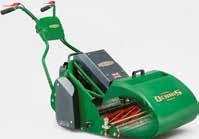



Adviser tool has been developed. This is an online member directory of advisers that have successfully joined the Register based on their experience and expertise and are committed to their continuous professional development.
The tool is a way to find a local adviser that can help with a particular aspect of interest: basis-reg.co.uk/environmental-advisers/find-an-adviser
Progress is being made on negotiations to relocate a century-old rowing club so redevelopment of Nottingham Forest’s City Ground can take place.

Following discussions between partners and key stakeholders, including the GMA, Sport England, sportscotland, Sport Wales, DCMS, Football Foundation, The FA, RFL, SAPCA and England Rugby, a joint statement has been produced relating to the use of rubber crumb in 3G pitches and the sustainability of artificial grass pitches.
“Artificial grass pitches (AGPs) are recognised as a durable, safe, year-round playing surfaces, able to withstand intensive use and all kinds of weather. The pitches are used for playing multiple sports including football, hockey and rugby and they are an important community resource that mean more people can benefit from the social and health benefits of physical activity.”
“However, concerns have been raised about the environmental impact of these pitches. Most commonly this relates to the fibre loss of microplastics and,
in the case of third generation or 3G pitches, the presence of rubber infill, which is also a microplastic. We understand these concerns and are taking them very seriously.”
“We are aware of potential developments in the EU following the European Commission’s statement (released in September 2022) which recommended the introduction of a ban on the future sale of ‘intentionally added microplastics’ onto the European market, which includes rubber infill for 3G AGPs.”
“The Sports Councils and leading sport bodies are working together to understand what the EU ban will mean for the stock of 3G AGPs in the UK and the timings for any legislative decisions.”
To find out more visit the SAPCA website: sapca.org.uk
Among the proposals are for the Peter Taylor Stand to be demolished and rebuilt to double its capacity from 5,000 to 10,000 people. The current stand is expected to be demolished at the end of the current football season in May, with the new stand then set to be completed by summer 2024.
But the club will not be able to commence any work on the stadium until it meets the condition of relocating the nearby Nottingham Britannia Rowing Club’s boathouse in Trentside North. The boathouse has been sitting on the banks of the River Trent since 1869 and is listed as an asset of community value.
BASIS awards two CPD points for ‘paid-for’ subscribers to the hard copy version of Pitchcare magazine, due to the diverse range of content that relates to the control, management and use of pesticides.
Subscribers can now obtain a further two valuable CPD points for their Professional register, simply by paying for a subscription to the hard copy version of the magazine.
Anyone wishing to claim their points should email their full name, BASIS membership number, date of birth and postcode to kerry@pitchcare.com






Back with anot her industry-f ir st , EGO’s new Z6 st eering wheel model drives lik e a car and turns lik e a zero -t ur n simult aneously for ultimate st eering control and conf idenc e. Feat ur ing new e-St eer™ Technology, a pr ecision st eering wheel and the latest in digital st eering technology – it also of fers the same world-first batt er y platfo rm-compa tibili ty as all EGO ride-on models


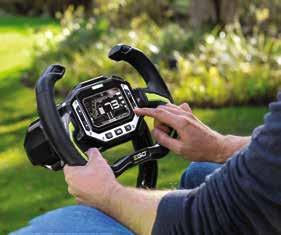



To find ou t more visit egopowerplus.co.uk

The full approval ensures Acelepryn will be in place in time for the key chafer white grub application timing in late spring, and to target leatherjackets at the most appropriate timing in the autumn.
allow optimum timing of application to best coincide with peak pest activity in specific situations, advocated Syngenta Technical Manager, Sean Loakes.
Sarah Hughes Syngenta Turf Business Manager
The label now covers control of chafer grubs and leatherjackets in sports pitches, golf greens, tees and fairways, golf roughs, racecourses and gallops, bowling greens, airfields, and professional application to commercial and residential lawns, subject to specific restrictions on the percentage of the area being treated.
While Acelepryn had previously been available for several seasons under the restricted constraints of an Emergency Authorisation, the full approval will
“For leatherjackets, changing climatic weather patterns that influence adult crane fly emergence, and subsequent egg laying, has frequently been occurring later in the season. The full approval for Acelepryn will enable more flexibility in the precise application timing for more effective results against early-stage larvae activity,” he advised.
Reporting of crane fly activity on the Pest Tracker website over recent seasons has identified peak flights of adults can occur right through to mid-October, with optimum application held off until the correct timing.
“Monitoring of adult activity will be especially useful when Acelepryn is being
A full approval for the innovative Syngenta insecticide, Acelepryn, now gives the chance for greenkeepers and turf managers to develop more effective integrated solutions for turf soil pest
.
used in an integrated programme with NemaTrident nematodes, where soil temperature and moisture later in the season is important for the predatory nematodes.” Turf managers can now keep Acelepryn in store between seasons for use at the most appropriate timing.
The UK label approval for Acelepryn allows for one application per year on permitted surfaces, at a rate of 0.6 litres per hectare subject to specific label. Extensive trials have shown the treatment is recognised to give good control of leatherjackets and chafer at the 1st and 2nd instar stages.
Syngenta Turf Business Manager, Sarah Hughes, highlighted the damage caused by soil pests has been of increasing concern over recent seasons.
“Leatherjackets and chafer grubs can cause catastrophic damage to high quality sports surfaces, as well as high risks to players and horses where root damage results in the instability of turf,” she warned. “The issues have been occurring over an extended period with changing climatic conditions.”
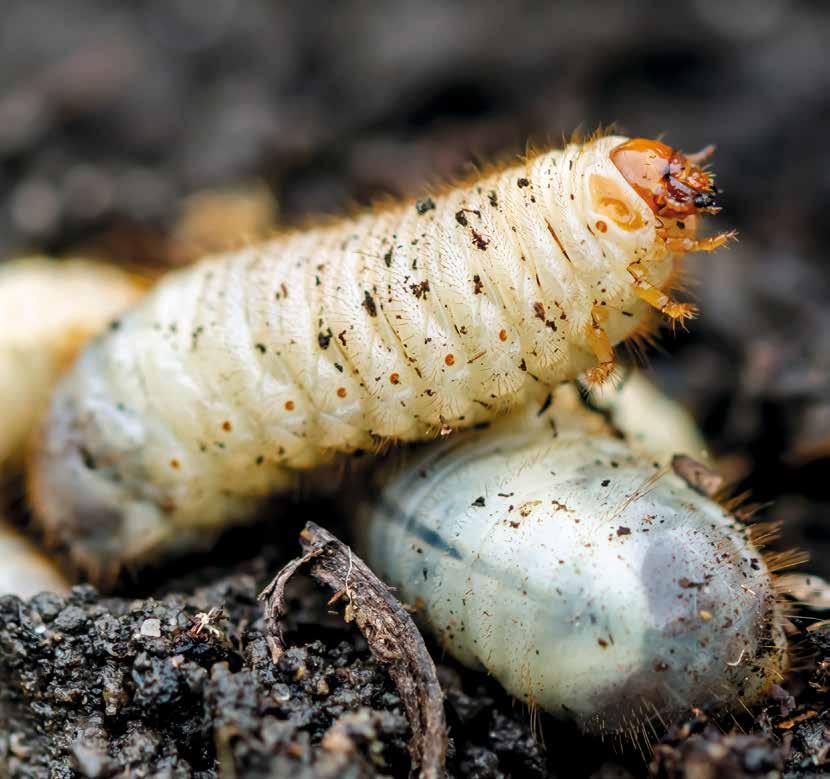
“The approval for Acelepryn will enable turf managers to develop more effective integrated turf management (ITM) programmes to tackle the severe effects of these pests.”
Sarah added that new Syngenta research on golf courses and fine turf surfaces has investigated measures to refine the application timing, managing aeration practices and irrigation scheduling to maximise control, along with the potential to use Acelepryn
in conjunction with effectively targeted NemaTrident beneficial nematode treatments. The best results with Acelepryn have consistently been achieved from application timing to have product in the soil to target early feeding larvae. Application at water volumes of
500 to 600 l/ha and using the white Syngenta 08 XC soil nozzle will ensure better penetration through to the surface. Users are reminded to follow the seven-step plan to optimise results, available to download on the Syngenta website, along with full compliance with the label recommendations.
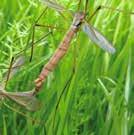

Use the guide below to help identify the leatherjacket (crane fly larvae) and three of the most common UK chafers.

There are six chafer species in total in the UK with the garden chafer being the most likely to cause damage to turf. Nematode species which can control both leatherjackets and chafer grubs alongside appropriate treatment times are also stated. Nematodes give some level of control of all chafer species but are most effective against the garden chafer.
Leatherjacket Tipulaspp.
Adult
Active: May–June and August–September
Larvae
Garden Chafer Phylloperthahorticola
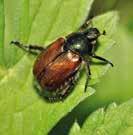
Cockchafer Melolontha melolontha Welsh Chafer Amphimallonsolstitialis
Active: May–June
Heterorhabditis bacteriophora
August–October July–October
Secondary
Active: April–July
Active: June–August
It is difficult to differentiate chafer grubs. Identification is best undertaken when the adults are active.

Heterorhabditis bacteriophora
August–October
Heterorhabditis bacteriophora
August–October
Treatment of chafer grubs is only possible in the late summer/early autumn. March–April
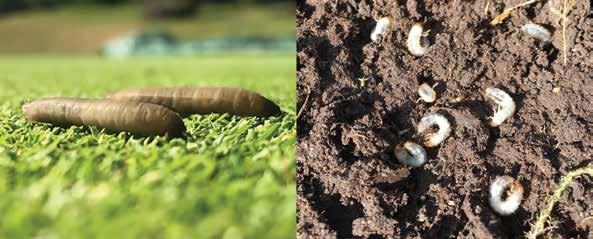


A suitable integrated pest management plan for these soil-dwelling pests will involve: identification of the pest, establishment of action thresholds and treatment priorities, monitoring and appropriate action. Undertaking these steps will help to reduce the threat of damage caused by chafer grubs and leatherjackets.

Categorise areas of site according to priority
Identify which pests are present
Set action thresholds and monitor pests
Apply relevant treatment if required and when it will be effective
The phrase integrated pest management is used a lot, and here Dr Marie Athorn from the RSPB and R&A partnership talks about how nature might play a role in helping.

Legislative reduction of pesticide use is affecting golf course management across the UK. These changes are vital to protect our environment. So, let’s discuss how nature can help you reduce some of the pressure and damage that pests might cause. Several species considered as pests on golf courses are actually food sources for a range of species in the UK.
One of those species is Starlings. Starlings feed on leatherjackets, especially during the breeding season. They need to feed their chicks something juicy! Starlings have small thin beaks and so, when they feed on leatherjackets in greens or tees, they don’t leave damage. Starlings have declined by 82% in the last few decades, they are however still widespread in the UK, albeit in much smaller numbers. Starlings take well to bird boxes that are designed for them. Putting Starling boxes up around your golf course means that the Starlings that use them will hopefully feed on the leatherjackets on your golf course. So, by helping Starlings have somewhere to nest, you may also help your own cause.
Monitoring and recording when adults of each pest species are active will help to show the severity and distribution of the pests and when to begin monitoring for the larvae.
Chafer beetles can be monitored using a chafer pheromone trap.

Use a sweep net or visual monitoring to estimate numbers and establish distribution of crane fly (adult leatherjackets).
In subsequent years the amount of adult activity could be used as a reference for likely larval levels.
Several bat species also feed on crane flies. They will feed over habitats that attract insects, so if you can manage areas of woodland, grassland and wetlands naturally, this will attract bats to feed on your golf course. Bats will roost in natural cavities in trees, so try and retain trees with natural cavities like cracks and rot holes, or why not make and put up bat boxes across your golf course. Do remember though, bats are protected - once the bat box is up and being used, it would need a licensed person to advise before you can move it – so think carefully about where you place them!
Monitoring of larval numbers and distribution can be used to determine when action thresholds have been reached and economic or aesthetic damage is likely if appropriate action is not taken.
Using a hole cutter, remove soil samples from several locations within each area that is being monitored. Alternatively, use plastic sheeting overnight to encourage the larvae to the surface. To ensure that a representative view of the area is obtained, use a standardised methodology such as walking a W-shaped transect or use a grid system to sample at regular distances.

Ensure that:
• The number of larvae in the soil has reached the action threshold
• The soil temperature is within the tolerance limits for the nematode
• The soil is moist and has been aerated
• Further rain is forecast or you can apply irrigation
• It is early in the morning, in the evening, or it is a cloudy day as the nematodes will be killed by UV light
Immediately after application irrigate well using at least 2-5 litres per m2 to wash the nematodes into the soil.
Continue to keep the area well-watered for at least two weeks.
Head Greenkeeper at Newquay Golf Club, Dan Kendle, gave us an insight into how he has implemented a quality level of pest management to his course.



After being a part of Operation Pollinator back in 2020, Dan had a mission for his IPM journey: “We have suffered from leatherjackets for about the last six or seven years. Over this time, we introduced wildflowers to encourage more insects and then brought in more bird species. We have an estuary, which means we have lots of birds who pass during migration; they will feed on the leatherjackets and then go to the estuary.”
Dan explains the need for a sustainable approach to IPM: “There is no silver bullet anymore, like with chemicals of the past. We have introduced bug hotels to encourage birds that will feed on the leatherjackets and other insects.”
He explains: “Despite not having any nesting boxes, we have about three or four hundred starlings. They make their own habitats - either in Newquay town or on the course in bushes. Three years ago, we had Cornish Chuffers (a member of the Crow family) come back to the course. They had actually gone extinct in the seventies and it’s nice to see them coming back because of the changes we have made.”
Dan has turned his attention to educating members about the sustainable approach: “We are not home and dry with leatherjacket problems. As head greenkeepers, we should really try and get as much information out to members about what is going on with the course management.”

He started: “It was like something from a horror movie. The spraying window had passed, so I knew the only option was seeding and rolling.”
“We all learn about leatherjackets in college. It shows why education is so important because you learn exactly what an infestation looks like. They like damp mild conditions, so we accommodated the perfect conditions for them to thrive.”
John thinks it could have been much worse had he not acted quickly: “If we had left it for much longer, the birds would have removed so much of the surface that it would probably have been unsavable. I had to make a few makeshift scarecrows just to be able to try and control the birds. All told, I lost about 45% of a 125-metre squared green. My saving grace was that it was two greens and not ten.”
John continued: “The situation has completely changed my perspective and definitely opened
my eyes up to which seed to use. It was the first time that I’ve used ryegrass on the course and it helped to get growth quickly.”
“The outbreak also made me appreciate how important agronomists are with advice on everything from seeds and fertilisers to growth regulators. Ronnie Frame from Agrovista Amenity takes soil samples every month and we speak regularly to ensure all bases are covered.”
“Since this issue, I have noted down the temperatures and rainfall every night in my diary. I am much more OCD about pest management now.”

The new Kress RTK n robot mowers extend unmanned mowing to larger areas. They ef ciently operate in parallel lines and autonomously move from an area to another, as if they were driven by humans.
No need for boundar y wires, nor on-site aerials. Available models are capable of maintaining grounds from 3,000 m2, right up to 36,000 m2.
Speak to your local garden machiner y dealer today to learn more.
This course is designed for those who wish to pass the FACTS examination leading to the Certificate of Competence in Fertiliser Advice. It will also be of interest to those who have qualified for the BASIS Professional Register and want to gain Continuing Professional Development points.
The course assumes a basic prior level of agronomic knowledge which then builds on principles and practice of fertiliser recommendations and nutrient planning.
It is essential that delegates are familiar with a range of nutrient issues, and have sufficient supervised field experience before attempting the exam.
Our Troubled Rivers aired in March. It turned the spotlight on nitrate and phosphate leaching into our waters and this issue is mainstream in the public eye and firmly in the focus of legislators.
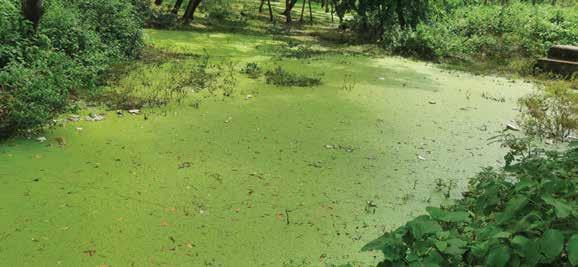
The comparative scale of inputs by amenity vs agriculture are small, but there is no escaping that our sector must, and will be forced to play our part in improving our environmental footprint when it comes to nutritional inputs.
So, what can we do as an industry to play our part and get ahead of the curve?
As a recent gradate of the BASIS FACTS course, passionately and charismatically delivered at the STRI by Dr Christian Spring, undoubteldy some of the answers sit with stewardship and education on fertiliser
use. Traditionally considered a course for perhaps ‘the more responsible amenity trade manufacturers and distributors’, it was encouraging to see a practising Golf Course Manager and School Grounds and Estates Manager undertake the same qualification.
With 55% of England’s land classified as Nitrate Vulnerable Zone (NVZ), can undertaking a BASIS FACTS really help you and your organisation in procurement, nutritional decision making and safeguarding nutrional inputs in the future?
I asked Daniel Ratling Grounds and Estate Manager at Whitgift School and Andrew Kerr MG of Surbiton Golf Course to share their experience with an ‘end user perspective’.
Daniel Hughes, Head of Commercial, Agrovista Amenity - BASIS
DANIEL RATLING
I undertook the BASIS FACTS training and assessment in 2022. I am responsible for agronomic assessments and writing our nutritional programmes. I wanted to ensure my CPD was up to date and that I was compliant with industry best practice.
The course delivery was excellent. Dr Christian Spring was engaging throughout the three days and the follow up sessions were well delivered. My colleagues on the course were knowledgeable and it was valuable mixing with people from other sections of the industry. The assessment process felt robust, I revised hard and happily passed.
Much of the technical course content I had covered previously throughout my studies, but it was still useful to refresh and bring up to date. We touched on agricultural regulations (NVZ’s) and post-Brexit legislation which was useful. I think the focus on minimising environmental impact is the main theme I took away. This is something we all need to consider and act appropriately now before legislation/ restrictions are imposed.
I would encourage anyone with responsibility for nutritional inputs to undertake this course. It has real relevance across the industry including for practitioners.
In a documentary aired recently on BBC2, Comedian turned angling supremo Paul Whitehouse boldy stated; “Whether it is the actions of industry, water companies, agriculture or us as citizens, our rivers are taking a battering.”
ANDREW KERR
Your motivation for doing BASIS FACTS as a Course Manager
� To ensure that I have all the facts and knowledge about fertilisers - including the theory, manufacturing process and the pros and cons of all products available
� To improve my understanding of the limitations of fertilisers and ensure cost effectiveness of applications and prevent budget wastage
� To understand the current environmental impact of fertilisers.

The course itself was very well run - despite the pace making my brain ache a little at times! It went through all aspects of fertiliser uses to ensure we had a background of both theory and practical knowledge.
Christian is very knowledgeable, and therefore any questions were answered concisely and were easy to understand. Doing the course as a group was very beneficial to share knowledge and experiences. Coming from different backgrounds allowed us to help each other look at the information from different perspectives which also helped greatly. How do you feel it has benefitted you as an end user and buyer of fertiliser?
I now have a better understanding of fertiliser and how this can affect the environment, especially reaching water courses. Plus an understanding of the impact on different soil types and the science behind the uptake of the nutrients and how they are used.
The nature and properties of fertilisers


Organic fertilisers
Crop nutrients and the basis for calculating the amount of fertiliser required

Use of fertilisers on the main crop groups in the UK Transport, storage, handling and labelling requirements necessary to protect the environment
Codes of good practice


Royal Liverpool Golf Club is located in the small town of Hoylake, at the northwest corner of the Wirral Peninsula. The golf course extends between Hoylake and the neighbouring town of West Kirby.
It has a single 18-hole course, which is a seaside links. Robert Chambers and George Morris were commissioned to lay out the original 9-hole course, opened in 1869 which was then extended to eighteen holes two years later. This fact makes the club the second oldest golf links in England, pre-dated only by the Royal North Devon Golf Club, in Westward Ho! Devon.
It has hosted numerous major professional
tournaments both male and female. Notably, The Open in 2006 with Tiger Woods finishing in first place, the now AIG Women’s Open in 2012 being won by South Korea’s Jiyai Shin and more recently, the last Open hosted at Hoylake being won by Rory McIlroy who lifted the Claret Jug in 2014.
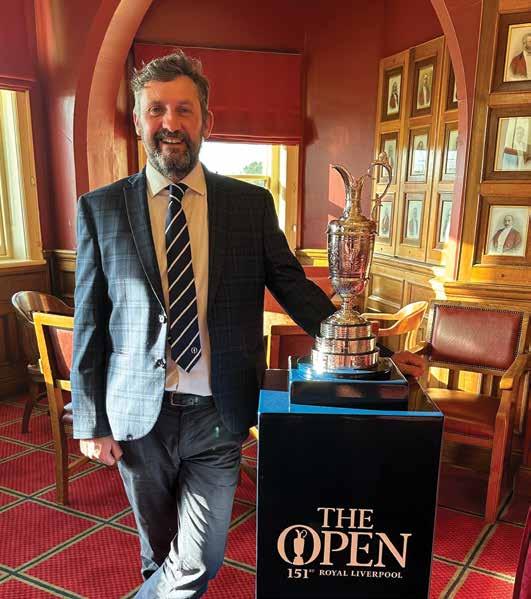
‘Bledge’
For those of us in the sports turf world, who have been fortunate to have met or know James Bledge, we all can testify that ‘Bledge’ is a very personable golf course manager! Now don’t worry, I’m not being rude by calling him by his surname, ‘Bledge’ has always been so-called
since childhood (even Mrs Bledge calls him ‘Bledge’)! He is a firm believer in achieving the absolute best results through his people and, to that end, is a great advocate of education, skill development and career progression. Bledge has always been hungry for more tournament golf experience, stemming from his early days preparing for the many Dunhill Cup competitions whilst at Kingsbarns Golf Links, and through all his tournament support volunteering work. One of Bledge’s many respected attributes is his all-encompassing passion for communication, whether that be to his Board, membership, or his team. “Not only do I get a great sense of accomplishment from communicating, but I also thrive on hosting large golf tournaments,” confessed Bledge, “and I prioritise my beliefs in promoting fine grasses and encouraging sustainability, whilst utilising all of the modern technology available within our industry.”
His story starts upon completion of his National Certificate in greenkeeping back in 1996 and landing his first role as Assistant at Dumfries & Galloway Golf Club. During his five years, he also achieved his Higher National certificate (1998) and later in 2004 his Higher National Diploma in golf course management



before he received the calling for a one-year stint at Norwegian club Miklagard before returning home to Gullane Golf Club in Scotland for a short term. In 2006, he got the opportunity to join the team at the prestigious Kingsbarns Golf Links in Scotland as Senior Greenkeeper. Whilst there, he got his first taste of tournament life, helping to host three Dunhill Cups. In 2009, Scandinavia called again, this time a grow-in experience at the PGA Swedish National in the PGA resort in Bara around 6 miles east of Malmo.
A year later, with grow-in completed, a return to Scotland and gWest International Resort, as Senior Greenkeeper for yet another grow-in of their heathland/fescue dominant course; a position he held for three years before his move ‘down south’ to Royal Cinque Ports Golf Club, Kent. Initially, it was as Course Manager, before being promoted to Golf Course and Estates Manager soon after. His role developed into full management of the entire golf course and estate, responsible for a team of twelve, including both course and estates budgets and responsibility for short and long-term planning at the club. This is where we now pick up the story with Bledge, as he embarks as Links Manager at Royal Liverpool Golf Club, and as he prepares for one of his greatest challenges (and in any turf manager’s career), preparing for one of the largest sporting events in the world - The Open.
Like most successful managers, Bledge is obsessive about detail and planning! As any good turf manager will testify, good planning
The newly constructed 17th par three hole, has been designed by Martin Ebert of Mackenzie and Ebert fame, built by Golf Link Evolve in 2020. The 330-metre square postage stamp size green is surrounded by revetted bunkers and a host of sand scrapes whilst perched atop a sand dune!
To the rear of this spectacular green flows the river Dee estuary, and Bledge points out that he and his team get great satisfaction from working with The Cheshire Wildlife Trust to help support and maintain the two kilometres of estuary banks which form the club’s boundary.



The eighty-two bunkers all are constructed with revetted faces; fifty being remodelled by the team over this last winter. They are sprayed with total weedkiller, then routinely scorched with propane gas burners to keep them ‘clean’ and free from weeds and grasses. The sand (sourced from the course) is currently brushed up the faces with smooth rakes for the members, which helps the ball roll into raked centres. For the tournament, it is planned that the sides will be levelled, which will make the bases a little more punishing for the professionals.

ranges from daily, weekly, monthly, and usually quarterly programmes, and sometimes yearly, which all help everyone in the business understand where they are travelling. Bledge’s office walls are covered in a myriad of wallcharts (which he has dotted in strategic positions).
Bledge explains, “I have a magnetic board
on duty for the week. As any manager will tell you, the weather is crucial to everything, so I look on my weather app. and write that up on the board. Once those items are logged, I can begin to programme what we need to achieve agronomically, from cutting regimes to dressings and applications of products. Lastly, I input my personal diary which helps me make sure I know where I must be at any given time or day, whether that be attending the many club meetings or my husband/dad duties!” laughed Bledge. He is the first to admit that all this information is ‘old school’, but as he could testify ‘it works’. “I communicate to the team verbally in the morning or as the day progresses and then my deputy and/or senior greenkeepers pick up the baton with the team for the rest of the day.”
Royal Liverpool’s capital expenditure programme for machinery replacement is on a rolling yearly basis. In this way, the club is not committed to any one manufacturer or fleet deal. “I can outright purchase annually what I need,” explained Bledge, “as it becomes available on the market. That way, we get the most up to date equipment as opposed to having to wait years for a finance deal to expire before we can start again. It works extremely well, and my fleet is always being refreshed with the best on offer regularly.” Bledge was rightly quick to praise his mechanic, Phil, who maintains this impressive armada of equipment, always keeping it in tip top condition.
Bledge runs a mixture of diesel, petrol, hybrid and all electric machines, and confesses that he would like more electric once he has developed the infrastructure to support an all-electric fleet. The maintenance facility has a mixture of red, green and yellow equipment, but stand out pieces are his Toro triplex all electric 3370s which he uses for greens, tees, surrounds and approaches. Interestingly, I asked about his
ratio of using hand mowers and using triples on cutting greens, “We usually use triples 75% of the time but reduce the frequency leading up to events, favouring hand cutting. Leading into The Open, we will obviously drop out the triples and go 100% hand mowing with our all-electric Toro flex mowers.” Explained Bledge, “As we approach the event, we will increase some of our fleet numbers, as an example from six hand mowers to fourteen (we need six teams of two to cut each day, two being spare), fairway mowers from
three to eight, utility vehicles seven to fifteen and triple mowers from three to six. The extras are being kindly donated from John Deere and Toro, and each manufacturer will be supplying a mechanic to help Phil keep everything sharp and operational.”


The devil is in the detail
As turf nerds, we all like to know a little data around benchmarking, especially for a Championship. Bledge informed me the height


of cut on the predominantly bent greens are currently 4.5mm and will be dropped to tournament height a few weeks leading into the event. The R&A’s goal tends to be around 10 feet 6 inches on the stimpmetre, of course this is wholly dependent on moisture levels and prevailing weather conditions. To achieve this, the team will not be planning on excessive rolling, but instead favouring hand mowing single cut, double or triple cut to achieve the desired results.


Collars and approaches are currently at 7mm, and fairways are currently cut at 11mm but will most likely be reduced to 10mm for the event. Roughs are cut at two inch and deeper rough cut at four inches. As we discussed all things cutting
heights, Bledge hinted that wouldn’t it be amazing if heights of cut could be more uniform at around 7mm or 8mm throughout the course from tee to approach in the future (watch this space for future update)?
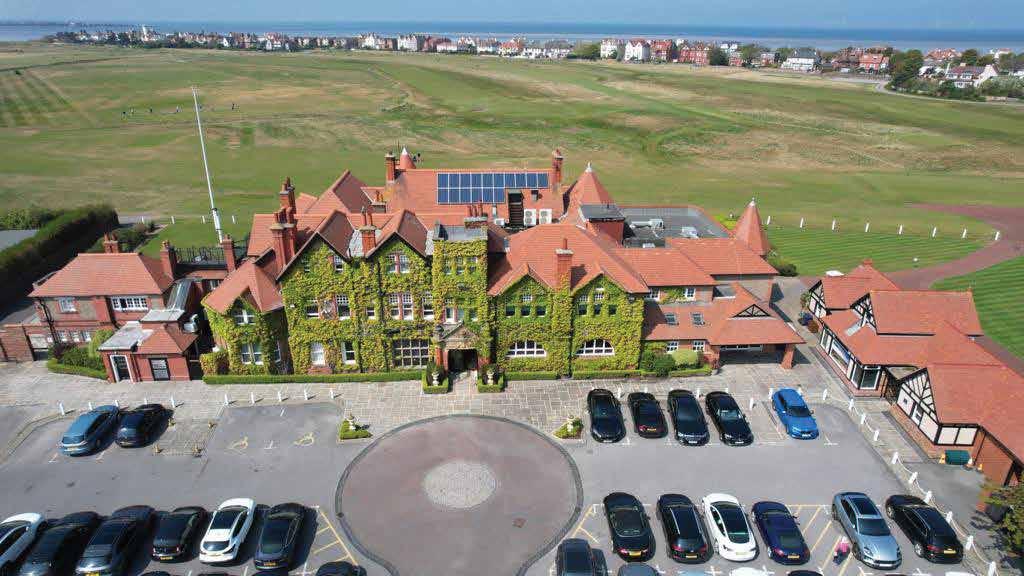
The greens have been dry jetted four times over the last twelve months, with the help of Ken Siems; with shallow sand injected over deep injecting, as the organic levels are better deep down. It’s all about firmness, with Clegg hammering at 115 gravities now and The R&A will be hoping for significantly greater firmness than that for the Championship. Bledge plans to dress greens once more before the tournament, but have been applying approximately two hundred tonnes a year historically which has helped.
Obviously, all turf managers understand their responsibility for sustainability and environmental awareness, and Bledge and his team are no different. The club has already gained it’s GEO certification, but the team have not rested on their laurels in driving even more great environmental projects recently. One such project is sand harvesting from site.

Bledge explained, “We use approximately 3,000 tonnes of sand every year for our topdressing programmes and bunker sand topping up.” He went on,” We dress greens, collars and approaches, tees and fairways regularly and so get through quite a bit in a year! Not only would it cost the club a fortune to buy all that sand, but it would cause an impact on the environment, hauling all this material around the country to get it to us.” As well as using harvested sand from the golf course,

the team use any waste material gained from around the course when conducting remodelling works (primarily bunker revetting works) and re-use once it has composted down. “We use this for all our divoting and it’s another great example of using what we already have on site.”
Water consumption is very much a sensitive issue when it comes to turf maintenance. This has been compounded over recent years with drought warnings on the increase up and down the country.
The Royal Liverpool team comprises twelve full time greenkeepers, a fifty strong artisan group of members (his fairway divot party) and a small posse of six local school kids for weekend course set-up duties. Again, planning is key for this small army, and is no mean feat, but with Bledge’s O.C.D. for planning he modestly makes it look simple!
When The Open comes to town, the team will be bolstered by an additional forty-seven crew, all sourced from local clubs. Bledge was quick to add that he was particularly proud of the competition the club ran to give an opportunity to two greenkeepers who otherwise might not have been able to join the support team. “We did an apprentice competition via Twitter where I asked five greenkeeper-style questions. The two winners won an allexpenses paid opportunity to join our team for the tournament week.”

Royal Liverpool has a state-of-the-art Rainbird irrigation system, with heads covering all the major playing surfaces across the eighteen holes. Despite the water efficiencies the system already provides, the team nonetheless carried out an audit to investigate if there were any further efficiencies that could be made. They soon realised that by introducing a separate head next to each green head, they could save water if only collars required water (instead of setting the greens head to arc more and waste water). At the same time as this instillation was taking place, they took the opportunity to add a hand watering point next to the heads. “Hand watering is an additional water usage efficiency, and the closer hose points help reduce time and effort for the operator,” explained Bledge.
The irrigation audit also flagged up the wasteful outer lines of fairway heads. These 360° 700 or 900 series heads have systematically been ‘swapped out’ by 752 series part-circle

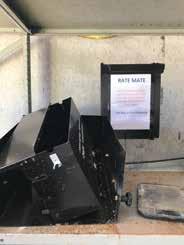
fairway heads. Bledge was quick to praise the mammoth effort his irrigation technician, Peter Lewis, had played in changing all two hundred heads over in the last few months! Worthy of note here too is that the ‘plates’ were different from old to new, and so all the custom yardage information had to be re-done too! Lastly, it was discovered that the heads which help irrigate the maze of turf pathways around the dunes are too large. It is planned to replace these to reduce water arcs, helping to only water the five-metre-wide area with what is required (smaller is better sometimes!).
Whilst discussing sustainability, and in particular the use of water and nutrient inputs (which again are modest and only used on an ‘as and when’ required basis), the turf composition across the entire golf course is hard top and sheep’s fescue. These grasses are supported across all playing surfaces (except greens) and are renowned for their drought tolerance and ability to thrive under low nutrient inputs; it’s what all great links courses aspire to.

It just leaves me to thank Bledge, his team and the club for allowing my visit at such a busy time - it was a privilege. The environmental guardianship work they have all completed is impressive and the future sustainability projects are extremely exciting and commendable. The golf course and playing surfaces are looking amazing and I’m sure all our readers will want to wish them all the best for delivery of a successful Open tournament. I hope they enjoy the excitement that it brings and the rest they deserve once the job is done!

 Article by Phil Helmn.
Article by Phil Helmn.

Bledges friends and family are very supportive of him.
I prioritise promoting fine grasses and encouraging sustainability


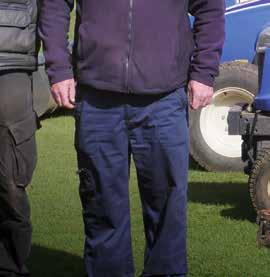



That was the conclusion of the Sustainable Golf conference, staged by Lancashire Golf at Hurlston Hall Golf Club, near Ormskirk recently, which addressed agronomy, energy, water conservation on and off the course and tree management topics.
Targeted at course managers, head greenkeepers and club decision-makers, the event has drawn excellent feedback from the 130-strong audience, reports Mark Bardsley, Lancashire Golf secretary.
“Our aim was to support England Golf in its drive for sustainability initiatives and to raise awareness among clubs in our region, and nationally, of the challenges coming down the line that are set to impact them,” Mark says.

“Clubs are certainly keen to learn and understand more about how they can move towards sustainable practices, based on delegate responses.”
With its total of 140 affiliated clubs, second only to Yorkshire, Lancashire Golf numbers both elite and ‘rank and file’ sites under its wing, from Silverdale in the north of its catchment, and Royal Birkdale in the west to Manchester’s Davyhulme in the south and Ashton under Lyne at its eastern fringe.
The conference also marked Lancashire Golf’s launch of its grant scheme, aimed at

funding clubs with a £500 sum to help pay for sustainability initiatives. “A number of clubs have already approached us with proposals including solar panel installations and wildflower meadows,” Mark reports. “At the end of the year, we’ll present an award to recognise the best one.”
Continuing the theme, he says: “Most clubs are not fully aware of the challenges confronting them - water management for example. Reliance on mains water could become prohibitively expensive, which is why more sites are investigating access to water via boreholes,” he adds.
Trees have a major function in the sustainability equation for golf. They often line parkland courses, creating sweeping vistas for golfers to enjoy; but should they be left to edge fairways and holes, when greens teams may prefer to thin them out or remove them to improve airflow and reduce risk of turf disease?
“Trees can be important to the playability of a course,” states James Hutchinson, the then BIGGA Membership Services Manager for sustainability and ecology, and soon to become Ribby Hall Village’s Greenspace Advisor, who spoke about woodland management for the benefit of golf and how courses are excellent for the environment they are laid out on.

Golf clubs are in danger of missing the key challenges facing them in the years ahead, amid onset of climate change and pressure to introduce greener practices.
“Golf is in a precarious position,” states Dr John Fry, Research Lead at the Centre for Research in Sports Performance, University Centre, Myerscough, who commands more than 15 years’ experience researching and teaching sports-related topics.
“Year on year, player numbers are down, according to the Sport England participation survey, despite the upturn during the Covid pandemic,” he reports. “The challenges the game faces are not going away - they could worsen in fact due to the impact on resources such as sand, aggregates, banning of chemicals and regulatory increases.”
“Collaboration between management and greens teams will produce a co-ordinated approach to developing a sustainable strategy for golf that accounts for changing climate, scarcity of material resources and shifting patterns of consumer demand.”


“However, they do need managing,” he maintains. “If you don’t, and many golfers don’t realise that the trees are slowly but surely growing around them, they can cause major issues such as drainage and airflow problems. Also, and as all greenkeepers know, grass is a full-sun loving plant and one that will not tolerate much shade.”
Once shade is added to a golf course, he continues, the fine grasses do not perform as well as they should, and, as a result, pathogens and their subsequent diseases make appearances.
“We do need to be aware that native trees are generally excellent for wildlife, therefore we need to take that into account. Trees capture carbon too, but so do grasses,”James adds.
R&A gold scholar James has visited well over 470 golf courses across the UK and further afield and created more than 100 ecology reports. From his experience with courses, how well does he believe wildlife is fairing in the golf environment?
“In terms of golf courses, wildlife is abundant. You only need look around your own course to see that wildlife is often more numerous than the surrounding areas, including housing, parks and farmland. Put it this way, if people want to
Each golf club in the country should appoint a sustainability lead, believes Owen James, Sustainability Officer at England Golf, one of five presenters on the day.

”Some clubs, such as Royal Mid Surrey, North Hants and Woburn, have already acted on this,” he says, but the major barrier to wholesale adoption across golf is cost, Owen maintains.
“Sustainability leads have a major role in sharing best practice with colleagues, so that the benefits can spread throughout the game.”

see wildlife, they should head to their local golf course - asking permission first, though.”
Golf courses will play an increasingly important role as green spaces for the community as a whole. Should they be awarded heritage status to protect them from course redevelopment such as housing, to which more clubs are resorting to keep afloat?

“Unquestionably yes,” says James. “You would have to ask why places where golf has been played for 500 years do not have some kind of listing or protection on them.
The health benefits from golf are many (mental health and exercise
for example), but unfortunately not everyone knows this. I often think I am preaching to the already converted,” he says.
Does James think clubs should be given financial incentives to preserve and enhance sustainability, in the way the government allots money to farmers for pursuing certain agricultural practices?
“Very much so. We do have access to some funds including Woodland Trust tree planting, Fairways Foundation and so on,” he notes, “but where access to government funds are concerned, I feel we are lacking and near the back of the queue.”
Article by Greg Rhodes.
“I started out as a greenkeeper, so fully appreciate the pressures clubs are under to satisfy members’ needs, but it’s vital that both sides - on and off the coursehear the same message about driving through sustainability. If greens chairs are not hearing it, the necessary conversations may not occur.”
England Golf launched its sustainability strategy in June 2022 and currently works with more than 1,700 clubs on ways to best forge change.
“Sustainability has so many sides to it and every golf club is different,
but England Golf’s message that adopting it is ‘Good for Nature’, as stated by the R&A, presents a sound benchmark.”
Greens teams may usually focus on biodiversity and agronomy in their quest for sustainable golf, Owen says, but the clubhouse can also benefit in terms of energy management and green technology, reduction of single-use plastic, fitting low-flow taps and improving materials recycling.
“Considering the carbon cycle is
important,” he stresses. “Coffee grounds can be sent off for recycling, for example, rather than them just going to landfill. There are a plethora of ways to improve practices.”
Tools can be used to measure and monitor the carbon cycle in the mission to ‘decarbonise the clubhouse’. “Some were built fifty years ago and more, and are carbon intensive. Golf courses sequester some carbon naturally, but we have to change the way we have always done it, on and off the course.”

Kerry Haywood speaks to a selection of British manufacturers to discover the impact of Brexit, the pandemic and global logistics and what that means for turfcare innovation.

Cresco has been importing and distributing spreaders since the 1970s and, over the years, have seen it all. Director Marcus Palmer told us about the challenges they have faced.
In February 2016, David Cameron set the date of the EU referendum to be 23rd June that year. From that date, multiple macro-economic factors affected us so dramatically that we had to rethink and reinvent our business. A hidden effect of the decision to hold a referendum was the devaluation of £ Sterling by 20%, effectively increasing cost prices of imported goods.
We have faced the Brexit challenges which have been magnified with the Covid pandemic, global logistics issues and the more recent Russia/Ukraine conflict driving inflation. At no time since WWII have we encountered such a difficult period to be in business.

Brexit has undoubtedly had a considerable impact on our manufacturing processes, with
changes in trading relationships, regulations and supply chains. We have had to grapple with increased customs checks, tariffs and non-tariff barriers, leading to delays and higher costs. These challenges forced us to adapt and innovate, seeking alternative supply sources and distribution channels.
With the development of the CRESCO product range, we implemented strategic changes to minimize disruptions and maintain competitiveness in the market. We focused on establishing strong relationships with international suppliers and investing in research and development, showcasing resilience in the face of Brexit-related challenges.
COVID-19 further complicated our situation. Lockdowns, social distancing measures and reduced demand in various industries led to disruptions in
production and distribution. We pivoted and adapted our operations to ensure the safety of our employees while maintaining productivity.
Our agile response to the pandemic involved quickly implementing safety protocols, adopting remote working where possible, and reconfiguring production lines to cater to shifting market demands. This proactive approach enabled us to navigate pandemicrelated challenges and maintain a strong presence in the industry.
Global logistics played a significant role in shaping our manufacturing landscape. The pandemic highlighted vulnerabilities in global supply chains, prompting us to reassess our logistics strategies. Faced with shipping delays, capacity constraints and increased freight costs, we re-evaluated our reliance on American suppliers and prioritised other international sourcing where possible.
We adapted by investing in digital technologies to streamline our supply chain management and enhance visibility. This focus on innovation and agility allowed us to better navigate the complex global logistics landscape and continue to deliver quality products to our customers. By embracing change and prioritising strategic investments in technology and international partnerships, British manufacturers can continue to thrive and contribute significantly to the UK's economic growth.



Brexit has forced BMS to make some strategic changes to their operations, including employing and training additional staff and bringing more manufacturing in-house. This includes additional engineering, welding and technical fabrications, which provides more control over quality and lead times. These changes have helped the company to reduce their reliance on overseas suppliers and improve their ability to respond to customer needs.
While raw material increases have affected some areas of the business, BMS has been working with supply partners to mitigate the impact. This has become a large part of the company's daily duties, and they continue to look for ways to manage costs and remain competitive.
To support their growth, BMS has recently relocated to a new, larger facility. This move will allow the company to expand their product development and research and development
efforts, which will benefit their customers in the long term. With a focus on innovation and new product offerings, BMS is poised to continue their success in the amenity industry.


Despite the challenges of Brexit, BMS remains optimistic about the future. In fact, since Brexit, their export business has doubled with new partners in Europe and other countries. By focusing on their strengths and investing in their people and facilities, BMS is positioning themselves for long-term growth and success.
From the company owner, the changes brought on by Brexit have presented both challenges and opportunities for BMS Products. By taking a strategic approach to their operations, investing in their facilities, and staying committed to their customers, BMS has been able to adapt and thrive in the new business landscape. As the company looks towards the future, they remain optimistic about the opportunities ahead and are excited to continue their growth in the turf care and amenity industry.
Brexit also posed a huge challenge, due to the vast amount of paperwork and documents which were required to get products into Europe. We had a lot of training to overcome these issues and it has been a seamless transition. The pandemic created another challenge when the phone suddenly stopped ringing and people could no longer have demonstrations. At the start, the order book had gone to an all-time low but, as things improved, the order number rocketed past any previous year. Product sales grew 46% and, in 2022, we grew 35% on top of that previous year. It remains (as of April 2023), approximately three times what it is normally this time of year; both petrol and
As far as logistics are concerned, obtaining components has been a massive challenge. It can range from weeks to months and, in some cases, in excess of over a year to get hold of some components.
We have seen a 25% increase in the cost of components. We have done our best to keep control of the costs, but unfortunately, the
cost has had to be passed onto the consumers. Energy, electric and gas bills have more than doubled, therefore manufacturing costs have had to also increase.
Despite all the challenges, we have continued to invest in innovation including new products and further development of our electric range of products. Further investment came at the end of 2022, when we purchased Lloyds Mowers of Letchworth and Hunter Grinders. Continual


It has been a challenging time for nearly all businesses in the Sports trade. Post-pandemic has seen peaks and troughs with some benefits of surges being seen after pent-up demand.

As manufacturers, two of the most impactful issues; post Brexit and the pandemic have seen high increases in raw material costs and this was only compounded by a huge shortage of supply and elongated supply chain delays.
We would have all expected these issues to lessen as the pandemic became less impactful to our daily lives, however, the events in Ukraine have meant costs have only continued to rise further as much of the world has to deal with resourcing certain vital materials and energy costs - increases at levels not before witnessed.
These increases have been compounded again by the welcomed progress of quality of life, but ill-timed large hikes in the living wage rates and a desire to do the right thing by staff, results in some hefty and very much unprecedented labour increases in the past few years.

All in all, this has resulted in higher prices across the marketplace, with the end user seeing large increases in cost alongside suppliers and manufacturers also losing out with a drop in margin.
There has been a lot of challenges and these will continue with high inflation, but we will adapt and succeed. We are always looking to try and do the right thing for consumers, clients and staff alike.
Logistics has been a major challenge for the manufacturers of the Dennis and SISIS range of grounds maintenance equipment.
As a business, Harrod Sport have very much navigated our way through troubled waters in a positive way,
We are over the worst of it nowIan Howard Managing Director Howardson Group Kevin Utton Sports Sales and Marketing Director, Harrod Sport





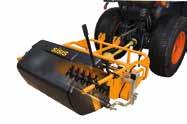




In recent history, the club has either been vying for promotion or battling relegation from the Premier League. The 2022/23 Championship season is no different, with the Canaries two points off the Play-Offs with four games left. Whilst this a familiar position for the club’s players, staff and fans, it is the first full Norwich experience for Head of Grounds, Adam Grantham.

In October 2020, Adam was made redundant by Reading Football Club after sixteen years. Having ascended the ranks to Grounds Manager and overseen the build of the Madejski Stadium (currently the Select Car Leasing Stadium) and Bearwood Park training ground, he was still enjoying his role when his time was cut short.
He explains: “Covid hit us, and then there was a period of financial decisions by the club which involved me and about twenty other staff that were put on a list for redundancy. So, unfortunately, I was one of the casualties of that.”
“You do miss it. I missed the team as well, a good bunch of lads, a very hardworking bunch, and I was sad to say goodbye to them, really.”

It’s a new challenge and a new project for me - I’m enjoying it.
“I took some time out, and it was a tough pill to swallow then. Obviously, just coming out of Covid and thinking, is there going to be anything for me?”
“I chose to stay in the industry, but as a technical consultant, which gave me a good grounding from the other side of the fence for a year. I didn’t choose to leave Reading Football Club, so my heart was still in grounds, and this was a great in-between job. However, I wasn’t finished in grounds, so it was great that
Norwich gave me that opportunity to get back into it again.”
Whilst Norwich was the job Adam was looking for, it was 166 miles away from his family and friends in Reading. The community of the club, their ethos and values all match his own, but the decision to move his life to Norwich was significant.
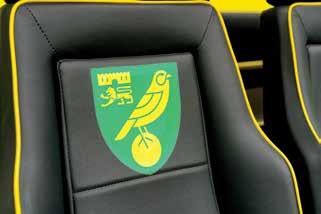




“It wasn’t an easy decision,” Adam explains. “Obviously, leaving family behind and my personal life changed quite drastically as well. So, coming this way on my own was quite daunting at the beginning.”
“There were a few doubts at the beginning, as you can imagine. Are the team going to be receptive to me? Are they going to take on my views? Is it going to be an uphill battle? Are the club going to back me? So, there were a lot of doubts in mind, but as time went on, everything started to slowly fall into place.”
“From a personal point of view, I’d say I was very unsettled at the start; coming into a new place and renting for a full year was tough because I had my own home in Reading. So, for me to go from that reality sort of hit home, I guess.”
“It was so disjointed. I rented three different places, and it was just trying to find that happy balance of working, going home, working weekends and bank holidays. There are things
Everything is budgeted, and it’s really well run
Foamstream’s unique blend of hot water and it’s patented solution is used by some of the biggest names of football for their weed and moss control on artificial surfaces.






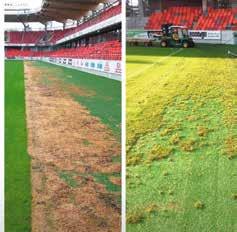
All surfaces

All weather
Used by: info@weedingtech.com


All year round in www.foamstream.com
Adam is full of praise for his team, which he “couldn’t do it without,” with Russ Allison and Dan Hales at the stadium and James Randall, Ady Gooch, Matt Cartledge, Brad Richardson, Scott Codling, Ciaran Tipple, Debbie Hooks and Stephen Johnston at the training ground.
With them, he was able to quickly adjust when joining during the season and adapt to areas he’s less familiar with, such as the vegetable garden and beehives at Lotus Training Centre.

“When I came in, it was assessing everybody and then going from there,” Adam said. “Having a development plan for my staff, then to become the next skilled person, next first assistant, next deputy and next head. So, there’s a career path I’m building and working on, which is the futureproofing of the grounds department.”
“For me, it’s getting the team around to the way I like to work. Getting the numbers up, and we’re recruiting at the moment, and it’s then trying to sustain that team and keeping them here, and everything else will
you missed out a lot on at home because you’re here and not just down the road.”
“When you’re here, you’re so consumed by the job that you forget a lot of stuff. Because your mind is so busy, and you’ve got your probation period, and you’ve got to prove your worth as well. And making sure you get on with the guys and getting your message across quickly and successfully as well.”
“When I finally sold my house in Reading and moved here, that was probably the first or second week of me moving in; that was when I felt at home for the first time.”
“But it’s finding that right balance. I’m a lot more comfortable and settled now than I’ve ever been since coming here fifteen months ago.”
Two of Adam’s main concerns when
joining were the club backing him and the receptiveness of his team. But, in the fullness of time, they have turned out to be two reasons his time in East Anglia is going so well.
The use of Raw Stadia has eased the learning curve and stopped him from having to ‘go in blind’ on moisture and hardness readings to the benefit of the pitch at Carrow Road. Bringing in testing equipment early on was also a positive sign the club backed him, and that is something Adam appreciates isn’t always the case.

“They are very much a forward-thinking club, very professional throughout, and it’s a joy to be here,” Adam said. “I toured the club with my boss, Greg Pillinger, and it was clear then they actively invest in the facilities, and grounds are no exception. We have a great setup here and that’s a massive bonus for me”
“When I first arrived, it was all (renovations) planned, but the great thing about this club is everything was thought of, arranged and budgeted, and it’s really well run, which is brilliant.”
“It’s great because I’ve had the full backing of the executive committee as well, which was a great privilege. It’s an appreciation of what I’m doing, which is great, and I’m very happy about that because it doesn’t happen everywhere.”
“I’ve been very fortunate that the things I have put forward have been agreed, and it’s showing what I am trying to do here is really working. It’s a new challenge and a new project for me, and I’m enjoying it.”
Article by Blair Ferguson.I’m a lot more comfortable and settled now than I’ve ever been












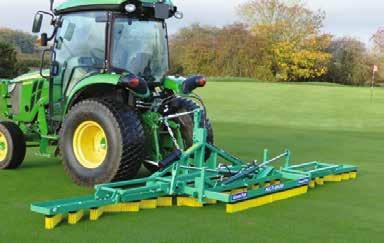



Surfactants can be found everywhere. You will find them in everything from detergents and shampoos to toothpaste, cosmetics, shaving foams and even fabric conditioners. Why are they used? Their role is to increase the wetting properties of a liquid. Surfactants are compounds that affect the surface tension between a liquid and a liquid, a liquid and a solid, or a liquid and a gas. Surfactants have a hydrophobic (water-hating) tail and a hydrophilic (water-loving) head. They lower the surface tension of a liquid and allow for increased spreadability.
For household products, these chemistries allow compounds to better penetrate dirt and oils, dissolving stubborn residues and removing them from surfaces. In the case of soil surfactants, these products alter the behaviour between water and soil and can be used to develop optimum conditions for turf surface performance.
In the case of dry, water repellent soils, the use of a curative soil surfactant such as Aquatrols Aqueduct sees the hydrophobic tail attach to dry soil particles and the hydrophilic head attach to water molecules – acting as a bridge to uniformly re-wet the soil profile. Alternatively, similar chemistries are used in surfactants designed for regular turfgrass programmes to better manage the relationship between the water and the soil profile through depth, improving moisture retention within
the upper profile or speeding up movement of surface water to depth.
The formula for water is H2O, and this tells us that one molecule of water comprises two atoms of hydrogen and one atom of oxygen bonded together. The water molecule has 10 protons – positively charged and 10 electrons negatively charged. Therefore, a molecule of water is neutral, meaning it has a net charge of zero. However, it is a strongly polar molecule, meaning it carries a partial positive charge near the Hydrogens, and a partially negative charge at the Oxygen. As a result, the water molecule is attracted to itself.
Cohesion is the force which pulls water molecules into a droplet, creating surface tension. When cohesive forces are strong, water forms droplets on a surface. A soil surfactant will reduce these cohesive forces, reducing surface tension.
The other force at work is the adhesive force influencing the behaviour of water molecules on a surface. When adhesive forces are strong, water tends to spread across a surface. A soil surfactant will increase the adhesive force, increasing the spreading of water over a surface.
In this article we discuss the technologies and benefits of wetting agents/surfactants and how managing rootzone moisture allows turf managers to have better control over their conditions.
Proven, reliable turfgrass products will usually consist of either one of these chemistries or a blend of these different chemistry types. For example, Aquatrols Fifty90 is a straight block co-polymer, Revolution is a modified block co-polymer, whilst Dispatch Sprayable is a straight block co-polymer and APG blend.
Not only do you have these different types of chemistries, but within the chemistries there are various chain lengths; these have a dramatic effect on how long the chemistries remain viable in the rootzone.

The amount of molecular chemistry within the finished product is also important. More chemistry = more active ingredient = better cost effectiveness. It can be difficult to identify what chemistry is in a soil surfactant from product literature or labels, however the Safety Data Sheet (SDS) can be an excellent source of additional information.
Polyoxyethylene - 1954


Reserve Block Co-Polymer - 1995

Wetting agents should be used in accordance with the desired outcome as not all wetting agent products utilise the same technologies. Similarly, you may not necessarily want to use the same wetting all year round. Wetting agents can be split into two groups, anionic or nonionic. The anionic wetting agents are the original technology developed in the 1950's which are negatively charged. These can cause dispersion within clay particles and have negative impacts in soil.
the amount of plant available water. Within the category of block co-polymer there are; straight block co-polymer to enhance water movement into the rootzone and reverse block co-polymer (retainer) which enhance moisture retention in the rootzone. Blends of both, straight and reverse block co-polymer are now commonplace within the industry, which aim to utilise the benefits of both technologies.
Straight Block Co-Polymer - 1996
Straight Block & Alkylpolyglycoside blend - 2000

Modified Block Co-Polymer - 2004

Aquatrols is committed to pioneering new methods that advance soil and plant health for turf. We take seriously our responsibility to deliver products that will enhance water use, thereby helping protect the future of our water environment.
The nonionic wetting agent group can be further split into two more generic groups. Polyoxyethylene (POE), which also originated around the 1950's and a newer group of block co-polymers developed in the 1990's. Care should be taken when using products that utilise older technologies as issues of phytotoxicity can arise, depending on application rates, grass species and environmental conditions.
Block co-polymers are now commonly used and are safe on fine and sports turf areas. They help to reduce water repellence issues in rootzones and soils, improve soil water content and
Other products available include those containing Alkyl Polyglucosides which make use of a sugar molecule reacted with a fatty acid to reduce water repellence. These can be mixed with straight block co-polymers and are widely used in the turfgrass industry. Lastly there is the unique modified methyl capped block co-polymer which creates a thin film of water around the soil particle which reduces the ability of the soil to completely dry out, meaning low volumetric water content can be achieved without becoming hydrophobic. Determining what the goal is for your site in relation to water management and distribution is key to deciding which technologies are going to help you achieve it.
any month of the year on rough and fairway height of cut turf, at greens height it often kicks off seeding with a vengeance once we hit around 100GDD cumulative from January 1st (using a 6°C base temperature for the calculation). This number does vary between
from a purely-temperature perspective, 2022 and 2023 are extremely closely-aligned. Below is a graph of the cumulative GDD from my default location at The Oxfordshire Golf Club, Thame using data from the Davis Vantage Pro2 6820 weather station on site. A big thanks to the course manager, Sean Wilson, for allowing me to use this data.
are given the very different weather scenarios
Readaboutthehighlysuccessful,DanishSeaScurvyhere (https://www.bbc.co.uk/news/uk-wales-21123964)
I have worked with Sean for over twenty years, and we know on his site that the annual Poa biotype starts seeding at around 100GDD cumulative starting from January 1st and the perennial at around 180GDD cumulative. When you look at the trace of the two years above, there are clear differences, but at these two GDD points, the dates are near identical.


In the past, this used to be the very end of April, start of May, but our warming winters are giving Poa annua a head start. Food for thought there I think when it comes to plant growth regulator timing.

Mark is well respected in the turfcare community and welcomes your questions. Send them to: editor@pitchcare.com






Sussex County Cricket Club was formed in 1839. The 1st Central County Ground, Hove, the club’s headquarters since 1871, offers the perfect balance between all that’s traditional in cricket with the needs of the modern white ball game.

It was for instance the first ground to install permanent floodlights, yet many of its regulars watch the game from the comfort of a deckchair. Day-night matches have been on the fixture list since 1997, when the ground was then only the second - behind Edgbaston - to stage cricket under lights in this country.
As if to reflect Hove’s perfect balance, it has the youngest head groundsmen in the first class
game. Ben Gibson is just 31 and has been in charge there for three years now.
All the usual optimism and joy at the prospect of bat on ball out in the middle was severely put to the test the day we were there because the spring equinox had served up a beast of a day. The covers were on and it was very much an indoor day. Sussex players were hard at it in the practice marquee.
Ben filled us in on his life as a cricket groundsman and his thoughts on the game generally.
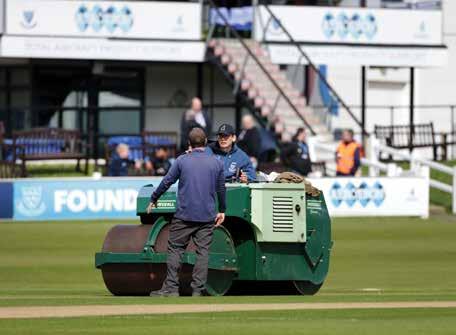
“I’ve always liked cricket, still do, but it was at an open day when I was at Brinsbury College,
to David Horsman of Horsham Cricket Club, where I lived, and he suggested I went along to the ground and talk to groundsman Roger Ward about helping him. It was a ‘why not - give it a go’ moment, so I did and worked with Roger for two years, completing my apprenticeship. He taught me a lot.”
“I got to know Sussex head groundsman Andy Mackay from his involvement in the county’s outground matches played at Horsham. I came and helped at Hove during the winter months, then in January 2011 a chance to join Andy’s team full time came along. After working here for two or three months voluntarily, as an intern
professional, my baptism into frontline cricket pitch care. Andy was the perfect mentor. I owe him so much.”
He went on to describe the set up at Hove.
“There are nine of us full-time all told. My deputy is Chris Deere and there are four other groundsmen based at the Hove ground. I also have three working at the club’s two academy grounds.”

“I’m big on a maintaining a proper work-home balance and everyone in the team can cover for anyone else during time off or sickness. It is important, especially during the summer, for everyone to get away from the pressure and
A lot of spectators and cricket followers just see scores. If it’s 600 for two, it’s a road; if it’s 100 for six, it’s doing too much. There’s always bit of a finger pointing at the groundsman. I can truly say that here at Sussex we always do our utmost to produce a competitive and fair playing surface.

routine of work now and again. I’m so lucky, it’s such a brilliant team. I’ll do whatever I can to keep it like it is.”
“Sussex CEO Rob Andrew, former England rugby international, is amazingly supportive when it comes to funding equipment and materials. We have everything we need. The club owns all its own kit.”

The Hove playing surface has probably the most distinctive slope in county cricket. Ben recalls that when he joined the staff Andy Mackay said there was a 10 foot drop from the north east to the south west boundary. “A lot of work has been done on it over the years, so it is somewhat less these days, but
nevertheless it’s a feature that has an effect on play. Bowling from the Cromwell End on the north side of the ground is noticeably easier than from the Sea End. Sides’ top pace bowlers nearly always opt for the former, and England paceman Jofra Archer, who leads the Sussex attack, was given Sea End duty when he first came to the county, but with seniority he readily switched to downhill.”
The square has 18 strips, but Ben only has eleven at his disposal for first class matches, dictated by boundary size. He says that over a season he will use each of them maybe twice. The central pitches are set aside for T20 fixtures, with probably an early Championship match or two to get this part of the square into play routine. It’s simply a matter of rotating the strips, he says. They play pretty consistently and the last to be relaid was probably five or so years ago.


Ben calls in contractors at the end of the season for annual renovation. Either Garsons or local firm Grasstex of Horsham help with koroing, top dressing and re-seeding. In the past couple of years, Ben says that all told 30mm has been taken off the square’s surface. Removal of the thatch layer is the main issue and it is always dealt with efficiently.
Once autumn renovating is completed, winter at Hove for the ground staff is a time for machine servicing, including blade grinding. He is always well stocked up with machine spares.
“Doing our own servicing is a real money and time saver. If a mower suffers a mishap on the outfield by say picking up a stone or small item of debris, we can have it back working in a couple of hours instead of having to get it shipped out for repair. Jobs in the workshop are part of what we all do. I was trained and so is the
rest of the team.”
Ben usually likes to get a number of rotary cuts done November time, but growth last year was slower than usual due to unhelpful weather and heavy rain washing away some of the fresh seed. Ben uses Johnson’s J Premier Wicket ryegrass mixture for outfield and square.


Conditions were far from favourable as winter became spring, according to the calendar. It was the day before the first pre-season friendly when we visited the Hove ground, but despite it

being cold, grey and drizzly in the extreme, the outfield looked decently green and lush. Ben said he was praying for sunshine and warmth to speed up growth. The covers were on though and Ben’s 18 strips were hidden from view. Odd as it seemed on this dismal day, Hove is statistically one of the better grounds for weather affecting play. Hardly any time at all was lost last season.
Ah, Sussex by the sea! Hove is rightly the home of deckchair cricket. Barmy breezes and factor 30 sunshine. But it isn’t always like that.

Paul Farbrace is in charge of coaching here now, and he’s 100 per cent interested in what we do and very knowledgeable about pitch issues.

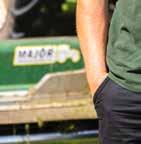

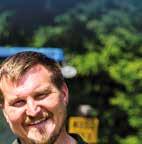

Models from 1.9m to 7.3m in a variety of configurations
Delivers professional, versatile cutting from 10-150mm



Fully galvanised for extended machine life

High blade-tip speeds finely cuts and evenly disperses clippings
The finish from the Major Swift is superior to anything we have used.
Nigel Allison, Grounds Manager, Newby Hall & Gardens, Yorkshire.
Ben says that not infrequently a decent day is spoiled by a quite sudden un-forecast cold sea mist, or fret as it is known, which makes watching and playing uncomfortable. The strength of the wind can be disruptive too.
Hove is the ground closer to the beach than any other, so it isn’t surprising that seagulls have an annoying presence.
“They peck holes in our sheets and damage sprinkler heads. I don’t blame them. They’re thirsty, and we offer a ready source of fresh water, but it is a nuisance we have to contend with year-round. They are rubbish spreaders too. Whenever we get a big crowd in, they peck at and distribute rubbish all over the place. They are messy devils, but it’s part of being at the seaside.”
“Quite often you can be mowing the outfield and one will settle in front of you and stay there defiantly - playing chicken you could say.”
In mid-January, a training marquee for players was erected at the Cromwell Road end behind the area of the ground always noted for its deckchair spectators. It is the third year Hove has adopted this pre-season facility, and for many of the first class counties it is becoming de rigueur as a means of creating outdoor playing conditions under cover. Sussex players use it three of four days a week in the run-up to first class matches, and the sound of bat on ball added an optimistic tone to a distinctly noncricket day.
Drainage at Hove has always been helped by its slope and is seldom a major issue. However, the bottom south west corner can have a tendency to hold water when there’s an excess of it, and there has been the addition of a little extra drainage to keep things flowing. Ben’s predecessor, Andy Mackay, made sure drainage
channels flowed around the square to avoid any overspill in excessive rain.
It is clear Ben is as much a cricket man as a groundsman, as we talk about the game as it is in 2023.
“The complex scheduling of white ball and 4-day championship matches means, like so many other counties, we don’t have outgrounds on our fixture list, which remembering my days at Horsham saddens me. For the time being, delightful grounds like Arundel and Eastbourne’s Saffrons are off the Sussex itinerary,” he said.
“The importance to counties of limited over success has gone through the roof in recent seasons. Winning is now so much more essential than it used to be, as is attendance, and the reliability of pitches under so much scrutiny. Having all your games at a single venue allows more control of things, and I suppose from the financial side of things makes sense.”
“I think all of us county groundsmen have added pressure these days to deliver quality pitches for every playing day of the season, though I’m very lucky here and the Sussex coaches have always been very supportive and understanding of the issues we have to overcome to achieve this.”
“If you’re a cricket groundsman, you know jolly well that you’re in the game, part of its process and outcome. In no other sport does the pitch have such a major bearing on how the game pans out. We have an active dialogue with coaches, umpires and occasionally match referees. We do have a say in things, good and bad, which keeps us on our toes. I love it.”
As a Sussex cricket fan, Ben was looking forward to a successful season for the club, but just then a bit of sunshine was higher on his wish list.

it takes a Smithco sprayer to be legendary. g

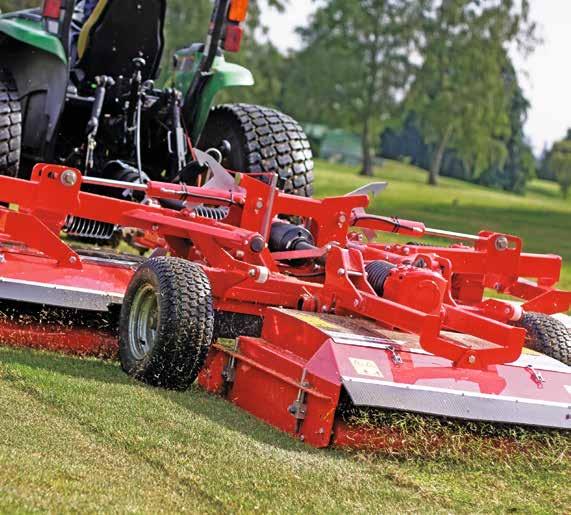
› Proven to provide a superior cut & spread.



› Articulated decks that seek out contours.


› Low maintenance & easy to use








› 3 year warranty & performance you can rely on.

In this regular column, we talk all things turf along with the projects and challenges you face on a regular basis.
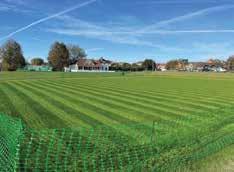

You have been here as both a player and volunteer for quite some time, what has changed the most over those years?

When I first joined as a player about sixteen years ago, we barely had two teams. Most weeks we were dragging people out of the pub to try and make teams up. We made a big push to get junior cricket started and now have around 130 girls and boys playing across seven junior teams at the club. This has been made possible due to the changes made to the surface and grounds management. Without these changes, we wouldn’t be where we are now. A really rewarding thing for me is the feedback. Recently, a young lad scored his first century; he came over and thanked me because of the surface quality.
What work has gone in to evolve the club?
Despite being a volunteer, I have a sports turf background and I have a lot of my own kit to undertake autumn renovations. We recently completed some Koroingwhich is something completely new to me and it has helped the development of the surface. In addition, we have also verti-drained and improved the feeding programme. It has taken two years to get to where we are now, but there is always room for improvement. The time and
expense invested in the last two years is considerable, but it definitely shows in the quality of facilities we have developed.
Have you received any additional help?
Tommy Walder has been managing the grounds for over twenty years and he has done all the real hard work. The committee have really stepped up as well and show a lot of interest in the maintenance and work on the surfaces. One thing to note is that we wouldn’t be here without the work of Robert Wilkinson. Back in 2010, he pushed for the club to keep going and, without his influence, it would have probably folded.
What did you learn from the experience?
I think the main thing I have learnt is to not always go with what’s in the textbook. Sometimes you have to go with what’s in front of you. The weather has certainly changed things in terms of schedule. For instance, we haven’t been able to roll the wickets yet because of the wet ground.
Have you got any plans for the future in terms of projects and improvements?

The focus for me now is to try and bring new people into the industry. I have a couple of young lads who are keen and I want to help them develop. That is a part of the industry which needs focus.

, talked us through changes over the past two years which have made a huge difference.
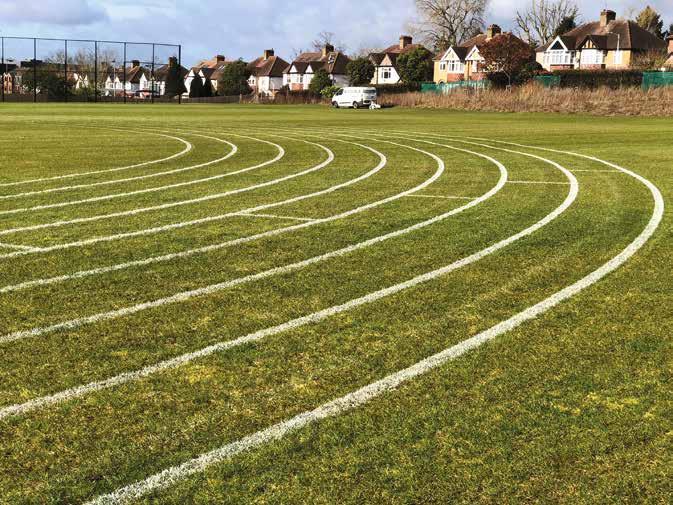

Myth: You can’t ask someone if they’re suicidal
Fact: Evidence shows asking someone if they’re suicidal could protect them. Asking someone if they’re having suicidal thoughts can give them permission to tell you how they feel and let them know they are not a burden
Luigi started by outlining what the Samaritans want to achieve: “We are a service for anyone who is struggling to cope - a lot of these are people suffering from mental health challenges. Big or small, our service is there for all people with (mental health) emotional problems.”
He expanded: “The Samaritan’s mission statement is to reduce the number of suicides. We are listeners and that is what is important. We allow people to speak freely and the key is to let them talk to us. We don’t make promises, but allow them to talk and hear themselves speak. We prompt people to find a route to their problems.”
“We are non-judgmental and that is what is important. If someone says ‘I am in a dark place, or I am thinking about taking my own life’, we would never say ‘Don’t be silly’ because nothing is silly and sometimes people need to get that sentence out. I can’t tell you how many times people say, ‘You’re the first person that has ever listened to me.’ It is so powerful; listening and talking is crucial.”
Luigi also clarified the difference between being an active listener and just listening: “When I’m listening to people, they have loads of friends and people who have their back, but often those same people might not just sit and listen to the problems. Listening and actively

listening are two completely different things. People call us to talk and we need to sit back and listen. That’s why we are here. When you are on a call with The Samaritans, or any supportive organisation for that matter, there are four ears listening in to the conversation. The things being said may be the first time that the individual themselves has heard that.
Can you explain more about mental health and how it builds up to an explosive point?
“Mental health is like a snowball, often it starts small and then builds up and up. Our plan is to try and stop people from going to the next stage. We are not a service for just those who want to take their own life. We are a service for anyone who is suffering from mental health. Big or small, our service is there for ALL people in need of emotional support.”
“If you’re working for a club and something goes wrong, such as waterlogging or damage to the turf, these are the worries that you might not think affect someone’s mental health. However, it is the build-up of these situations which affects mental wellbeing the most. Normally, it is years of build-up for someone to get to the suicidal stage. So, we need to focus on catching it early and trying to help in the early stages.”
Luigi went on to speak about the need for education about mental health, starting at the very top of the ladder: “Something useful
Luigi Munday has been an active speaker for Samaritans for five years. We spoke to him about his experience and how the organisation can help you.
would be an education and understanding of mental health in senior positions. It is about changing people’s perspectives to always remember that it isn’t just what is in front of you. If you have five people working on a pitch, every single one of them needs to be important. As soon as you point the finger at one of them, that is when they will deteriorate and be affected. Self-erosion is often caused by someone pointing the finger.”
“Let’s say you have an aggressive boss for example - if you are working for that person and you are feeling depressed, it is very unlikely that you will feel comfortable. However, if you have a boss who has been educated and knows about mental health, who naturally has a calm approach, then you would feel more comfortable going and talking to them about your mental wellbeing. An environment needs to be created where everyone feels comfortable.”






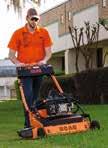
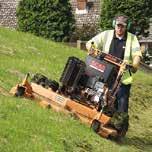
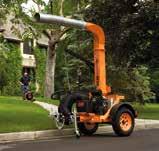


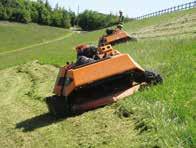


Whatever you’re going through, you can call Samaritans any time, from any phone for FREE: 116 123

Sometimes writing down your thoughts and feelings can help you understand them better: jo@samaritans.org

Get out in the sun. Away from work that is! Activities such as hiking and gardening throughout the summer months can be a great way to improve mental health. Studies show that being in sunlight can help boost the body’s serotonin production. Serotonin is the naturally occurring neurotransmitter that plays a part in regulating our moods, according to Harvard Health Publishing.
Reading. Not for everyone. However, reading allows you to escape from a chaotic and busy lifestyle. It also happens to be a great hobby if you have anxiety. Reading can help distract you from negative or intrusive thinking you may be experiencing.
Exercise. When we exercise, our brains flood with endorphins that boost mood, that’s according to Johns Hopkins Medicine. Not only does exercise boost mood, but it also allows any unwanted aggression and frustration to be released.
Myth: You have to be mentally ill to think about suicide
Fact: 1 in 5 people have thought about suicide at some time in their life. And not all people who die by suicide have mental health problems at the time they die. However, many people who die by suicide have struggled with their mental health, typically to a serious degree
Cooking. It offers a level of emotional relief that other hobbies may not. According to Frontiers in Psychology, cooking can help you relax and boost your happiness. I suppose I have always enjoyed the eating that comes from cooking. With each dish, you feel more self-reliant and confident, not to mention the social connections you can make when serving it to others.
Journaling. That’s not the type of writing that you see throughout this magazine. It’s the activity of regularly documenting certain situations to allow a release to occur. It’s often recommended for those with anxiety, depression, and PTSD. You don’t have to write a novel; research has shown that journaling for as little as fifteen minutes daily can help reduce anxiety. For example, writing about an incident at work that caused anxiety may allow you to feel a sense of release.
• You get radio silence
• They seem down
• They get emotional more than normal
• They keep cancelling plans or changing meetings
• Changes in performance/ lack of motivation/ inability to concentrate
• Extreme mood changes of highs and lows
• Significant tiredness, low energy or problems sleeping
• Working longer hours than usual or trying to do too many things at once
• Not taking care of personal appearance or leaving living space untidy/unclean (if this is unusual or out of character)
• Let them know that you’re happy to listen if they ever want to talk about anything
• Mention some mental health services that can help or offer to go with them to a session
• Encourage them to speak to their GP about how they’re feeling
• Check in on them by messaging or meeting up when you can to check if they’re okay
• Be patient with them, it might take some time for them to feel like themselves
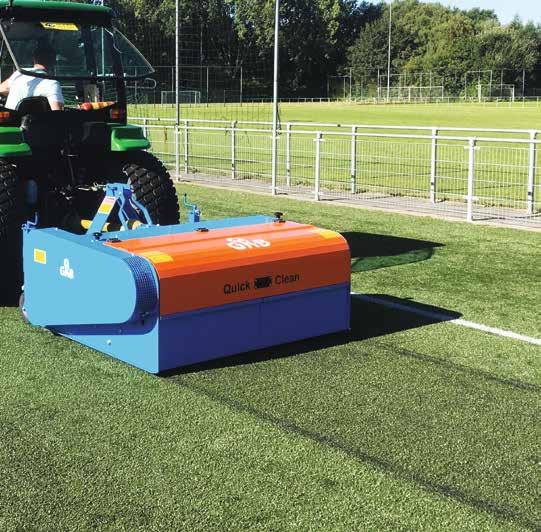
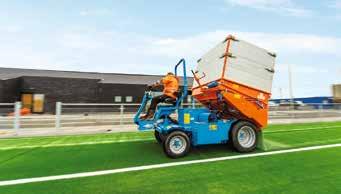



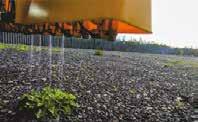




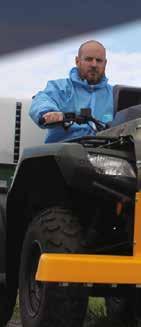

Visitors join us every year to celebrate the carpet of flowers



Easton has been owned and managed by the Cholmeley family since 1561. In recent years, the family and community of Easton have dedicated their focus to restoring the Estate’s historic spaces so it can continue to thrive in the future.
The hall and grounds were a natural sanctuary for injured soldiers convalescing during World War I. During World War II, the Estate was used as a barracks, during which time a large amount of damage was sustained - leading to the eventual demolition of the hall in 1951. Careful restoration and transformation since the early 2000s has brought Easton and its Walled Gardens back to life, for the community and the local environment.
From late January to March, Easton Walled Gardens plays host to drifts of delicate snowdrops. They emerge from a bulb formed in the previous March, after waiting patiently to flower for almost a year. The walled gardens boast an impressive ten different varieties of snowdrops - something that they are very proud of. Lady Cholmeley said: “The gardens are in a beautiful valley surrounded by parkland and it seemed a shame to allow them to collapse. The underlying aim is to create biodiverse habitats and to explore the world of plants through gardening. Visitors come year after year to join us in celebrating a new year of flowers.”
Easton is built on a team effort and Lady Cholmeley is looking to develop even further, with help from her team: “Tim Metcalfe-Kemp is our head gardener, who is ably assisted by senior gardener Sharon and part-time gardeners Rob and Ben. Our horticultural trainee, Chris Jesson, has just joined us. We are on very free-draining soil with lowish rainfall, so we are working on plans to develop a gravel garden.”
From a war wreckage to a garden spectacle, Easton has proven that a once-ruined land can be turned into something of a sight to behold. It is an open invitation to lose yourself in the heady romance of hundreds of years of horticultural history.
That’s what makes our industry so amazing, the diversity of jobs we can all enjoy and all we have to do is chose a ‘lane’. What’s wrong with changing careers from time to time if that spices up our life/ career or prospects?

Personally, I have often wondered what it might be like to alter career paths, I wondered what the drivers or desires are to steer you onto an alternative ‘lane’. I recently caught up with Pete Newton MG (irrigation technical sales rep with Reesink Turfcare UK), to chat about his change of direction and wanted to understand what made him want to switch careers, especially as he had already reached the top in the greenkeeper ranks. Undoubtedly, he is a great example of someone grasping
this opportunity extremely well and his story is one which I hope some of us contemplating alternative routes within our industry will find interesting as you read his ‘real life’ experience.
I have always been intrigued by the many opportunities we can all experience in our wonderful world of turf management and wanted to understand what drivers Pete felt to swap trades and move ‘over to the other side of the fence’, especially as he made the jump whilst at the height of the turf management ladder.
In the beginning…
So, how did it all start? Well, like most of us, Pete began working at his local golf club in the spring of 1997 at Rochdale Golf Club, Lancashire as part of his studies working towards his HND in turf science and golf course management at Myerscough College. Upon completion of his
Restricting ourselves to only one speed and one lane within our industry may not be wise, we should embrace and understand that all our roles run parallel, and we all rely on each other for success.
three year course (which he passed with flying colours), he successfully gained employment as assistant greenkeeper at the prestigious Marriott Forest of Arden in the Midlands and quickly climbed the ranks to first assistant during his five and a half years of service. Pete then moved to another Marriott venue, this time Worsley Park, again as first assistant before joining The Belfry team as deputy greenkeeper on The Brabazon course in January 2006. Then, Pete’s big break came with the move to Rockliffe Hall Golf and Spa two years later as Head Greenkeeper, then promotion to the role of Course Manager.
Soon after, this new role saw him take on the grow-in of their brand-new golf course, turning an adjacent potato field into a fivestar world class venue we know it as today. “The grow-in was an amazing experience,” explained Pete. “It was a huge learning curve for me, but one which helped me develop my

Toro/DeVere greenkeeper of the year 2006


B.I.G.G.A. delegate Las Vegas G.C.S.A.A. convention
59 Club greenkeeping team of the year 2014 Rockcliffe Hall Master Greenkeeper status 2015 B.A.S.I.S. foundation in amenity chemical control

Former mentor at the F.T.M.I.

organisational and communication skills.” He went on, “I’m very proud of that team which successfully completed the grow-in of the new championship course.”
Fast forward eight years from his time at Rockliffe Hall, and Pete grasped the opportunity to join the Reesink irrigation team as irrigation and aeration field sales and support operative under the stewardship of Rob Jackson and has, as they say, never looked back in the seven years he has held his new role!
The world of H2O
His key deliverables (other than the obvious sales objectives) are wide and varied but
consists mainly of support and assistance to the greenkeeper/groundsman community in all its forms. Admittedly, Pete does a lot of travelling as part of his role, which isn’t for everyone, and he is the first to acknowledge this, but the positive element is that he gets to travel up and down the country seeing and experiencing some amazing golf clubs and sports grounds and meeting a wealth of turf managers. As I probe about the strenuous travelling, he replies, ”when you love your job, it stops being a job,” he laughed. “It feels like I’m getting paid to see my mates.” This is due, in part, to his networking whilst he worked within the greenkeeper ranks.

Pete is a natural born communicator, and this aspect of his role is one which he not only relishes but thrives on. ”Put simply, I enjoy meeting people,” he explained. ”My role means I get to meet lots of my turf manager colleagues up and down the country every day. This business is all about people, building trust and through honest conversations building respect.” He continued, ”I get great satisfaction from helping turf managers understand the intricacies of key water management fundamentals and how best to use water efficiently, which is number one for me personally.
Pete went on to explain, ”It’s rewarding to be acknowledged as a turf professional, not just an irrigation guy.” He clarified, ”Greenkeepers and groundsmen who know my background, which has been built as working relationships develop, are more comfortable reaching out for a little turf management advice. It’s extremely fulfilling to be able to help and assist colleagues by supporting them in that way. It means that I get to share my experiences and knowledge from all my previous roles and think that it demonstrates that all our paths (or jobs) within the industry are intrinsically linked.”
 Article by Phil Helmn.
Article by Phil Helmn.
DEMO. NETWORK.


SPORTS & GROUNDS EXPO



JULY 19TH - 20TH 2023
The Green Business Expo to launch alongside SAGE this July.
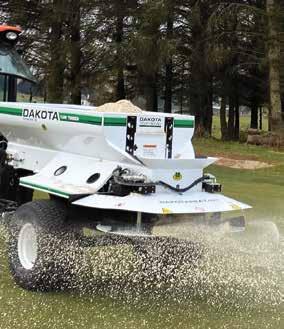





Creating a hub for sustainable practices and solutions for all sectors of industry, by accelerating access to pathways to achieve NET ZERO in time.

NO GREEN WASHING JUST STRAIGHT TALKING!

Scan me to learn more

Sleaford Golf Club recently brought home the UK Conservation Greenkeeper of the Year award for 2023 at the 29th GEA Annual Awards.

Nick Lawson, Chairman of the Management Committee, has been a member at Sleaford Golf Club for over thirty years, and was persuaded to join the management committee in order to bring his financial and accountancy experience to bear.

Nick outlined what had been done at the course to boost conservation: “The biggest project is the dry-stone walling around the course which has been five years in the making. Initially, we had a handful of volunteers coming to help with the wall and then that number grew to twenty. Last year, I obtained a grant from the Woodland Trust and we got 1500 new trees and over 500 metres of hedgerow.”
Director of Golf, Nigel Pearce, has been at Sleaford for twenty-three years and was the club professional. He highlighted how the work has helped rejuvenate the course: “It is important to note the old wall was in a serious state of disrepair and it was almost a health
hazard. It was something that we wanted to make a feature of the club again. So, Nick and his team have rebuilt all of the wall, which is roughly 750 metres around the course.”
Nick expressed the team effort that has gone into the conservation, wildlife and environmental projects: “Course Manager Brian Sharp and the team have done an excellent job to undertake the recent projects. The members have been great because they feel like they are part of the club and they are proud of the work that they are undertaking.”
Nigel added: “Every Monday, the members turned up to take part in rebuilding the course. The same team of volunteers that did the construction of the wall are now looking at the overflow car park project. We are getting busier as a club, so clearing another parking area will be beneficial.”
When asked about the project cost or challenges Nick said: “It didn’t cost us anything, as we recycled every stone from the old wall.
The value of the volunteers is amazing as it means very few labour costs. Combine that with the materials we already have and we are saving and developing thanks to the volunteers and recycling.”
The Golf Environment Awards 2023 STRI Group launched the Golf Environment Awards (GEAs) to recognise, reward and promote outstanding individuals and golf courses, for the time and effort they put into protecting and preserving their unique surroundings.
With the ever-increasing spotlight on environmental matters, it is fundamentally important for golf courses worldwide to assess what they can do to achieve environmental sustainability while continuing to maximise the enjoyment of golf.
Nick was crowned the UK Conservation Greenkeeper of the Year award for 2023 at the 29th GEA Annual Awards in Harrogate back in January and there was a vast amount


of work undertaken to make a fundamental positive impact on the surrounding landscape and biodiversity.

Nick outlined the projects: “Along with the dry-stone wall project, we planted over 1,500 native trees and 500 metres of new hedgerows, carried out wildlife work in the management of bird nesting boxes, hedgehog boxes and the construction of a brick-built barn owl towerwe also provided feeding and watering holes for them. We built log piles, bug hotels and a pond for mammals and insects - providing protection for bees and bats. Re-wilding areas that were previously mown, thus saving labour and energy costs and well as providing more wildlife habitat. We now harvest rainwater from buildings which is then used for water use on the course. Newly installed solar panels on the machinery shed roof provide electricity to run the Clubhouse and, finally, we now recycle materials where possible, eg wood chips from fallen trees are used for
to the Golf Environment Awards can choose from six categories to enter:
pathways on the course.”
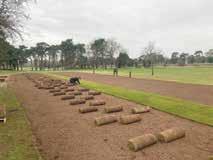
Due to the course being largely based on an SSSI area, working with Natural England came as a challenge at times. Nigel expands: “Natural England does restrict us. We can’t just go out and plant a tree or cut one down, we need to gain permission from them, however they have always been sympathetic to projects and our requirements.”
What do the members think?
Nick indicates that there has been a mixed viewpoint from members: “The majority of members love what we are doing, but there have been others concerned about what expense it has come at. This is where education comes in with members and we have communicated that the conservation work has cost very little.”
He draws on an example as he expresses the need to educate members on wildlife: “We built
an owl tower and I’ve had loads of comments about the look of it and how it’s an eyesore. Within three to four months a barn owl had moved in and I can showcase the image to members and online.”

What’s next for Sleaford conservation plans?

Nick suggested further work towards sustainability: “We’ve installed a rainwater collection harvester which holds 70,000 litres. We have put solar panels on the roof and installed air conditioning around the clubhouse to try and save energy.”
Nigel highlighted how much these changes have saved the club: “It has saved us around £6000 per year in energy. We have also installed LEDs in all rooms around the clubhouse. We are trying to do everything we can to reduce the use of fossil fuels.”

We are saving and developing thanks to the volunteers












Can you tell us a little more about what have you done so far?
We’ve recently recycled approximately 250 tonnes of rootzone, old bunker sand, topsoil and leaf mulch; screening down to 10mm topsoil for landscaping works and fines that will be used to top up sunken drainage lines in fairways.
When did you first focus on recycling and sustainability?
Our first recycling efforts started in 2007, when we converted the used oil from the fryers in the clubhouse kitchen to biodiesel using our own ‘Fuel Pod 2’. We converted 2000L a year, which saved us a tank load a year and around £1200 at that time. With fuel prices varying so much, it’s difficult to calculate the exact savings over the last fifteen years, but it would be something in the region of £20,000!
How important is it to undertake sustainability projects, especially given budget and price points are under strain?

With global costs of materials increasing (seemingly monthly), we are always looking for ways to reduce the number of materials being imported into the golf course, and thus our impact on the environment. We try to reuse materials wherever possible.

What is planned for the future?
We’ve recently purchased a chipper, so all the brush and timber from our tree works can now be chipped down and used for mulching on flower beds and some paths that are through woodland, so they remain a little more natural and rustic.
We have a ‘rolling’ five-year course improvement programme which includes reconstructing the back nine bunkers - in line with our course appraisal carried out by
architect Howard Swann. Levelling tees is a constant and ongoing process for us as we are on a hilly site consisting of London Clay, so movement is inevitable. Our biggest project on the horizon is to construct a reservoir to harvest rainwater from ditches that would flow into the proposed area. Once planning is approved, we are planning to use a reed bed system to filter out unwanted nasties.
Carrying out any improvement to the course is rewarding. It is great having such a capable and experienced team that can really get involved and take ownership of the projects we carry out. Every team member has input into the project and ideas are bounced around to get the best outcome. Making any teeing ground larger and flatter will benefit membership and provide better surfaces for more of the season.
Knowing that we saved thousands of pounds in topsoil being imported is also satisfying, and knowing that we have not had to have several artic lorries running into the course and the reduced impact that has had environmentally is also a huge positive.
How have the members reacted to the work that has been done?
Members enjoy new improvements and can now start to see the projects nearing completion. We will be undertaking course improvements every other year from now on, so the membership gets a rest from areas of the course looking like a building site over the winter months. This will mean that we can focus on our tree programme and ecology report that was produced by James Hutchinson from BIGGA last September - the focus of which is to remove the Leylandii and Poplar species from the course and plant deciduous native tree species.
Since 2007, Course Manager Andy Harding and his team have been on a recycling mission - saving over £20,000! James Kimmings found out more ...
The Club Board of Directors and the Greens Committee are incredibly supportive of the work we carry out and are very driven to improve the facility. Some Board membersincluding the Chairperson and Greens Directorhelp on our Tuesday ‘Work party’ which involves some of the more menial tasks.
CLUB SUPPORT
Cornflower: Centaurea cyanus

The annual wild cornflower is easy to grow and is frequently added to wildflower seed mixes. Cornflowers grow from seed to a mass of flowers in a few months, providing a buffet for bees and butterflies, food for birds and cover for other creatures. The key benefit of cornflowers to bees and other pollinating insects lies in their ample nectar reward from spring through summer,
Despite voles not being a common pest among many in the industry, they do tend to come out to play during the summer months.

Voles make holes about the size of an old ten-pence coin in the surface, especially on heavy land.
With the Wildlife and Countryside Act 1981 protecting our furry little friends, you might want to consider a more sustainable approach. Owls and other birds of prey have a strong appetite for voles so the best solution could be to simply let natural selection help to reduce the vole numbers.
Invasive Species Week 2023 took place recently to raise awareness of the impacts of invasive non-native species.
About 10-15% of plants and animals introduced to Great Britain become invasive non-native species which spread and have a harmful impact. Invasive non-native species are one of the top five drivers of global biodiversity loss. They threaten the survival of native wildlife, damage our natural ecosystems, cost the economy over £1.7 billion a year, and can even harm our health and interfere with activities we enjoy.
For example, when Rhododendron Ponticum (recognisable for its purple flowers) is in flower, it can damage our native flora and fauna. The
plant is responsible for the destruction of many native habitats and the abandonment of land throughout the British Isles. It is also poisonous for mammals causing concern for those who want to bolster the wildlife population.
Japanese Knotweed is another to keep an eye out for. It can be difficult to identify, but being able to spot the signs of a Japanese knotweed infestation early is advisable. It can be treated with herbicide, and this will stop the aerial growth that you see above the ground, but the roots, known as rhizomes, are capable of supporting life for up to twenty years.


The oak processionary moth not only strips oak trees of their leaves, leaving them vulnerable, but also poses a health risk to humans causing rashes and breathing difficulties.
What does oak processionary moth damage look like?
The oak processionary moth feeds and lives almost exclusively on oak trees. What does it do to the tree?
There is one generation of oak processionary moth per year. The caterpillars hatch in spring and go through several instars, eventually developing the irritating hairs. The caterpillars descend lower down the tree as they develop, stripping the tree of its leaves as they go, leaving it vulnerable and weakened.
In summer, they retreat into nests and pupate. The adult moths emerge in late summer, living for only four days in order to mate. The female lays her fertilised eggs high in the tree canopy and the cycle begins again. To find out more visit woodlandtrust.org.uk

Caterpillars in procession on the trunk nose-to-tail in late spring and early summer. The procession is sometimes arrowshaped.
Nests on trunks and larger branches of oak trees. They are made of distinctive white silken webbing that fades to a light brown colour.
Dislodged nests on the ground near oak trees.
The UK is at risk of losing millions of trees to pests and diseases.
James Matthewman analysed three varieties of seeds and said: “Do not be afraid to try different seeds, look at the climate and use the data.”
James (Deputy Head Greenkeeper at Maesteg Golf Club) said this on his seed selection: “Due to changing climates and our budgets, we have decided to experiment in terms of the seeds that we use, which led me to analysing the different varieties.”
“If you are having hotter summers, you might introduce
Variety Pros
Fescue
• Thrives in hot weather
• Fine leaf
• Excellent for surface roll
Bent Thrives in wet conditions
• Can cope with very close mowing/height of cut
• Can withstand the colder elements
Ryegrass Fast germination
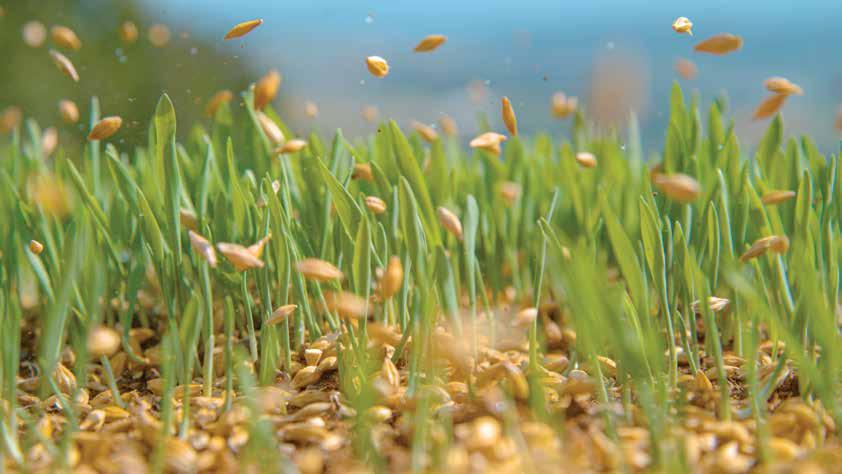
more fescue. Whereas, if you are experiencing wet winters, look towards sowing bent towards the end of the season ready for winter. Finally, if you are struggling with worn areas, do not be frightened to try ryegrass as it is very fast germinating. The most important thing is to look at your climate and choose what is best for you. Every surface is different.”
Cons
• Doesn’t like the prolonged wet conditions
• Difficult to germinate in cold temperatures
Causes a build-up of thatch if left unmaintained
• High maintenance is needed in the summer months. Regular watering would be required
Direct drill seeding
This is when the seed is drilled below the ground. Machines that carry out this work usually cut a groove in the sward, dropping the seed in behind the cutting disk. The groove is then closed over. Seed sown in this manner generally produces a stronger plant. Pitches are drilled in two or three directions. The depth of the drills is approximately 5mm.
Overseeding
Machines are usually fitted with a roller with small spikes attached which precedes the seed box. Once the holes are made, the seed drops out the back of the box into the holes. This method is preferred if seed has to be applied during the season.
Broadcasting
Germinates in colder weather
Provides excellent coverage The cheaper option out of the three seeds mentioned
Needs more feeding High amount of maintenance needed Regular mowing due to growing speeds
This is the traditional method. It is not accurate because of the difficulty in spreading the same width over a long time.








Prior to the second world war, Somerford Park Farm was a large country estate, and then became part of Cheshire’s important dairy farming industry. It was in this role that the 1000acre farm came into the possession of the King family. By the 1980s horses had become a serious passion, which turned into the bulk of the business by the Millennium.
Today it is home to 250 competition and leisure horses year-round, but as a leading competition venue can draw as many as 1000 equines at a time to its events.
This includes British Eventing’s Somerford Park Farm International Horse Trials which attracts leading horses and riders for dressage, cross country and showjumping and the LeMieux National Dressage Championships.
However, there is an equal focus on ‘grass roots’ riding, as Millie Heffernan (neé King) explains:
“We have six and a half miles of off-road farm ride, which like many of our facilities is available for all to hire and is included in the package for our residents. There is a summer grass ride, which runs alongside a specially designed all-weather
track that is open all year.”
Four large outdoor all-weather areas can be subdivided to make twelve arenas in total, all with Andrews Bowen surfaces. In winter, the showground arenas are transformed into a cross country practice area on the all-weather surfaces using portable fences, allowing riders to train all year round on five acres which includes a water jump complex, fed by the field drains.
One indoor arena is reserved for the exclusive use of residents; other facilities can be hired by internal or external clients.
“The construction and maintenance of the all-weather arenas is of the utmost importance,” comments Josh King. “The surfaces need to be able to withstand the wear and tear from some 15,000 horses per year.”
Each arena has a specific sand/wax content to meet the needs of its users, whether that is for dressage, show jumping or general riding, and each is harrowed with purpose-designed graders twice or three times a week.
Once a year, the arenas are stripped, laser graded, depth checked and resurfaced.
Eight full time staff are kept busy with farm and
Creating a natural looking environment – albeit with state-of-the-art synthetic riding surfaces where needed to provide perfect footing year-round – for a busy equestrian event venue takes a surprising amount of work.
equestrian facility maintenance; one is dedicated to mowing and harrowing.
In addition to competitions, an increasingly important income stream is riding ‘camps’, where riders bring their horses to Somerford for several days at a time for lessons, talks and socialising.


Major competitions are subject to tender, and Millie points out that a 3-5 year agreement is required to justify the investment needed to meet the requirements of a prestigious event.
“But events also generate business – leading riders will see the quality of our facilities and hire them for their private use for training.”
Set within 80 acres of parkland, more than 100 cross country jumps have been built and there is also a dedicated cross-country course reserved for the horse trials.

The British Eventing cross country course was designed by David Evans and Andrew Heffernan, coach to the Netherlands Eventing team, in conjunction with BE’s technical advisors, with construction and maintenance of its grass track equally exacting.
“It was developed fifteen years ago using an arena grass mix, and was drained by a local contractor,”
explains Josh. “We have a year-round maintenance programme and decompaction is key. I use an Imants Shockwave and a Verti-Drain and I really like the action of the Shockwave which works deeper and lifts the soil profile.”
A slitter is used for surface work, and a Sumo grassland subsoiler is deployed to lift any deep compaction.
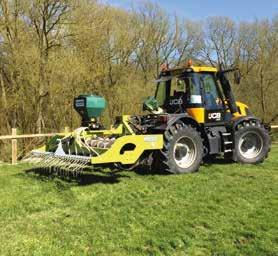
“Post-event, we topdress with sand from our own quarry using muck spreaders to cover the large area, putting on about an inch a year, a total of 300-500 tonnes, which helps to level the surface,” he says.
“We’ll then overseed with a Vredo slot seeder and continue with the decompaction programme until the following year’s event.”
“To keep it as a top level facility for a thousand horses to use over the course of the event, the exclusive use for competition and the intensive maintenance programme is essential.”
At the Somerford Park International Horse Trials a large grass area is divided into 11 individual dressage arenas, all carefully maintained to provide the footing for top level event horses in this phase.
“An Imants Penetrometer is useful to check compaction and plan repair work, and we’ve got our
Above: Left A careful fertiliser programme is used to produce a resilient yet high presentation sward.
Right Universally referred to as an ‘Agrivator’, this heavy duty aerator can be used in the run up to events to loosen firm turf surfaces and allow infiltration of any rain.
Above: An international standard crosscountry course is reserved for one major event a year and receives a high level of maintenance, including using an Imants Shockwave to tackle compaction.

Top right Somerford Park Farm has been developed by the King family into an equestrian events venue for top level competition including the British Dressage National Championships.
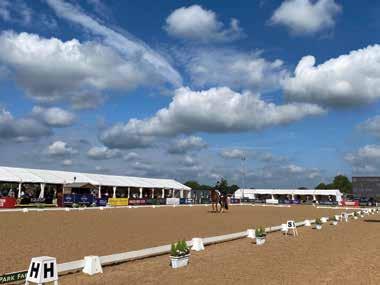
own irrigators if the ground starts to dry out.”
The farm ride was purpose-built, using sand over road planings to make a surface which withstands year-round use and accommodates more cross-country jumps; a grass track largely follows the same route and gives riders a river crossing to negotiate in the summer.
“The farm ride gets regular harrowing and we back blade into the jumps to keep the surface consistent,” explains Josh. “Then we use spiked rollers on the grass to alleviate compaction and encourage grass growth, and we’ll spread chicken litter to increase organic matter.”
Mowing is a substantial job; a Trimax tractormounted rotary mower has rollers front and rear
to give the required finish. “We couldn’t use a topper as it would tear the grass sward; grass quality and appearance is very important. We also mob graze sheep in the grass areas over winter, moving them on frequently to minimise damage. They are useful for levelling the ground, squashing any frost heave.”
All spraying is done in-house, and fertiliser application is tailored to the season – high P&K to encourage root growth to present a stable surface and withstand damage, and then N topdressing for a final green-up before shows.
Tractors are shared with the farm which has a handy line in producing some 18,000 bales of haylage a year for horse feed, sold nationwide.

The JCB Fastracs and an assortment of Massey Fergusons are all shod on grass tyres to minimise the impact on the turf, including wide Nokian 800 and 650s.
With two workshops and machinery stores on site, many infrastructure projects are carried out in house; for example, plastic temporary barriers are being gradually replaced with attractive portable timber structures.
Despite its large all-weather areas, Somerford retains a natural, park-like appearance with water features, trees and hedges, and its ambiance, along with the central location and good motorway access, was a major feature in
arenas.
winning the British Dressage tender in 2020 for that organisation’s most important show of the season, Josh reckons.
“We already had most of the infrastructure - a good number of stables with the space to easily add more and plenty of hardstanding horsebox parking. The Championships uses three large arenas with grandstands and hospitality suites on the showground for four days, and it takes around three weeks out of our calendar when you take into account set-up and breakdown time. We’ve had to put in some additional roadways, but they’ve been useful for other activities. Competitor and organiser feedback has been extremely positive.”
The pair comment that they would consider hosting other major events and broadening the scope of equestrian activity.
“We haven’t had much involvement in showjumping for example – as a family, our experience is with other equestrian disciplines, but it’s certainly something we’d look at,” says Josh. “We’ve also got planning permission for a showground extension, and we’re aiming to add to the eight glamping pods that we offer to event organisers and individuals.”

While the extensive stabling meets equine accommodation needs, most horse owners prefer to use their surprisingly well-equipped horseboxes for stopovers, and provision of showers, catering, electric hook-up and even wifi is all part of the package on offer at Somerford.
To cope with the logistical nightmare of hundreds of individual bookings for facilities, a local software developer has designed a bespoke booking portal where clients can request use of arenas, schooling facilities or the farm ride for a
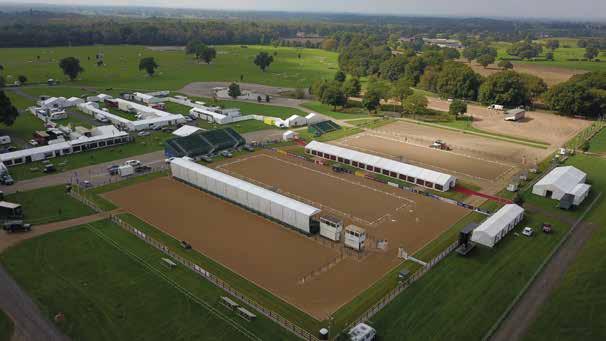
day and time of their choosing.
“This will be integrated with our event booking system so we can enter details of major bookings to give a full picture of the activities on site,” he explains. “We’re hoping that it can even be used for actions such as switching on and off the hook-up to a particular parking slot to coincide with the time of the client’s arrival and departure.”
In a country where the exploits of our Olympic teams – medals were won by British riders in Tokyo in all three disciplines - have driven a new passion for equestrian pursuits, the enthusiasm and innovative approach of this family business is tapping into it with great success.
Article by Jane Carley.Above Left The main showground can be set up in a multitude of ways for different events, using grass and artificial surfaces.
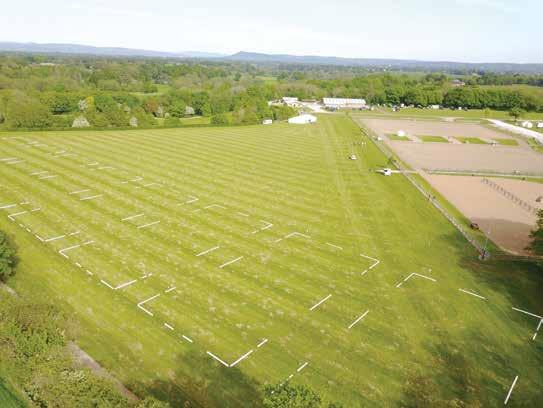
Right The high horsepower tractors are shared with the farm; turf tyres reduce their impact when on groundcare duties.
Below Preparation for the international three-day event.
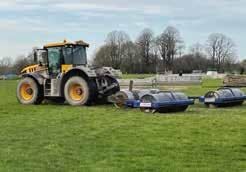
24.7 million rounds of golf were played in 2022 – that’s 11.2 million more than 2019 pre-Covid levels and the data shows that the average number of members per club, and how often members are playing, have increased significantly.*

But as we all know, 2023 is certainly not without its issues. Here, Jon Cole, divisional business manager - turfcare at Reesink Turfcare, distributor of Toro fine turf, sports and grounds equipment, considers the climate and the change in purchasing decisions.
Our order books reflect the stats – it’s been a buoyant time – and while this is fantastic news, one thing we and many machinery distributors
are still facing is a supply shortage. This is the proverbial elephant in the room, but really shouldn’t be. I’ll explain why.
After golf enjoyed a pandemic-fuelled resurgence in 2020, the question was whether that momentum could be sustained, and the answer has been a consistent yes.
Figures from 2022 show the professional game thrives as evidenced by the PGA Tour’s $427 million in tournament purses – an average jump of almost 14 percent per event, thanks in part to the debut of a new television rights deal – and the LPGA’s 12 percent prize money increase to almost $86 million.
Since the pandemic, golf has thrived by nearly all metrics including equipment sales setting a historic pace. There are more members and they’re playing more often in the UK and Ireland.
Perhaps of broader importance is the health of the game – official figures from the four UK and Ireland golf unions have revealed that participation in 2022 was the second highest since recording began showing, and that 5.6 million adults played at least one nine- or 18hole round of golf in Great Britain and Ireland in 2022. That was an increase of 265,000 from 2021, making it the second-highest number since monitoring began over 30 years ago*.
The demographic of golf has changed too.
The continued flexibility in work schedules and a renewed appreciation for the physical and mental escape that golf provides sees a much more rounded audience of men and women,

with the figures showing that 20 percent of adult golfers on full-length courses were female in 2022, compared to 15 percent in 2019*.

So, what does this mean? Well, it makes great sense with the state of the game in the healthy position it is, that as we came out of the pandemic, clubs started investing again and placing machinery orders in abundance, but, as we know more than ever now – supply doesn’t always meet demand.
We’ve found global supply and production networks are still working to catch up with the backlog from lockdown and the high ‘recovery’ demand. The ongoing delay in raw material
A promising sign from America is that 6.2 million millennials, or 28 percent of all golfers, played about 100 million rounds in 2022, further broadening the audience.
Source: National Golf Foundation
supplies and disruption to global transportation routes in general was expected to ease by now, but these pressures have in fact increased, exacerbating this industry-wide and global issue. Worldwide issues beyond anyone’s control have had a contributory factor to sourcing the necessary components to complete a machine for production. Most customers are fully converse with this now and planning their machinery replacements accordingly. Far more proactively than possibly historically.
Unfortunately, there’s another fly in the ointment as it were and it’s inclusive to all –rising energy prices.
Electricity prices in the UK rose by 66.7
percent and gas prices by 129.4 percent in the 12 months to February 2023** and were some of the main drivers of the annual inflation rate. We’ve heard the same problems from golf clubs running a spa or leisure facilities, to local sports clubs – there’s just less money to go around once the bills have been paid.
We’re finding there’s a correlating change in our customers’ purchasing habits. Previously, customers would replace their machines every five years using finance. Now, we see them extending that lease time frame to six or even seven years. There are several reasons for this. They’ve seen, by a force of hand, that due to the build quality of Toro equipment, they can easily get another year or two out of their machines before selling them on.
So, with every penny counting now more than ever, what are the ways to maximise budget and make monthly savings? Well, one way is to adjust

Accurate budgeting is vital and, for that, fixed costs are invaluable
the length of lease. Most customers buy their machines on a lease deal. This is economical and means they can buy more of what they need for less, turning one new Toro machine into a fleet in a cost-effective way. And what we’re seeing is some customers extending the length of their machinery repayment leases to assuage the supply chain issues until they settle (which is expected to last through 2023-2024).
We’ve often spoken about how important the Total Cost of Ownership (TCO) of Toro machinery is – how the lowest TCO is achieved through the purchase of productive, good quality equipment, made with the most robust materials, using



tried and tested technology. All of that is then supported by a preventative maintenance and repair regime provided by us, the distributor, to protect the machines’ longevity, performance, durability and reliability, as proven by Toro customers time and again.



A recent article in Forbes predicts purchasing behaviour will change in 2023 and place much greater importance on which brands and experiences are favoured than ever before, with the goal to squeeze maximum value out of each outlay. It will be the year of quality over
If there is a positive to be taken from the past two years for Toro equipment, we have proven that the machinery will last longer with fewer operating costs, reliability issues and with a lower depreciation of value than all its competitors.
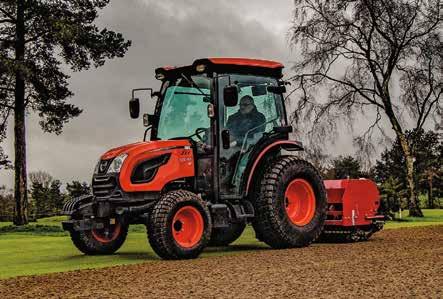
quantity, and less being more, which further reiterates the TCO point made earlier about considering the whole life cycle, not simply the purchase price.
The Toro name has long been synonymous with quality. Many moons ago, Toro was fondly referred to as the Rolls Royce of turfcare machinery. And to be honest, not much has changed in that respect, except that its association with quality is now a proven and tangible thing.

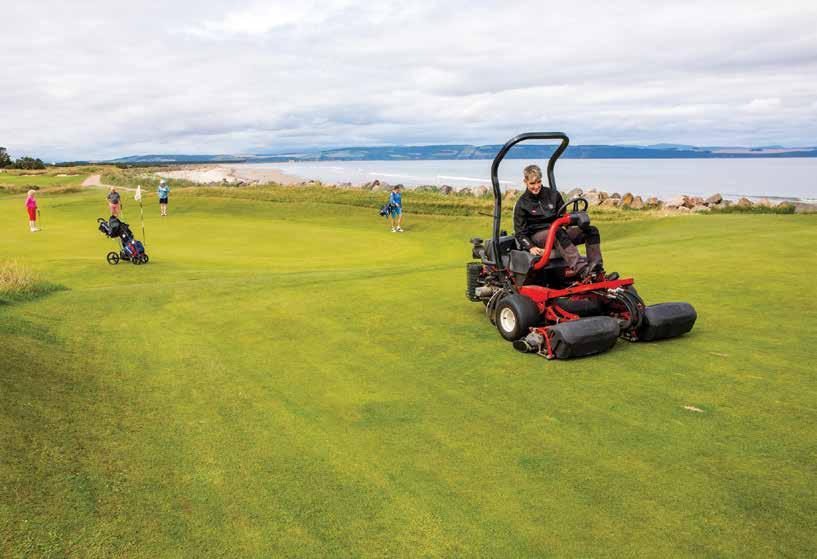
Toro is the first major manufacturer of turf care equipment to achieve the rigorous ISO 9000 standards. Each certification is particularly noteworthy because each represents a ‘first’ in their industries. Holding these certifications shows Toro has met identical, globally recognised quality requirements. While Toro already excels in providing products of exceptional quality, the ISO certifications elevates Toro’s leadership in and continued commitment to providing unequalled quality, performance and reliability, as well as fulfilling customers’ needs for the
certification to specify requirements for equipment purchases.
It makes sense then that peace of mind and financial security are key considerations in purchasing decisions in 2023, which is where finance comes in, offering all the benefits of ownership without or low capital outlay. Accurate budgeting is vital and, for that, fixed costs are invaluable. For Toro machinery with Reesink, customers can choose from three packages: lease purchase, finance lease or operating lease for a flexible and cash flow friendly way to get the machinery needed to maintain the business.
I can’t say I disagree with the prediction that 2023 will be a jumble of mixed signals: exuberance as the market grows, tempered by caution in the face of economic turbulence. Just know that whatever the market, finance and supply barriers to purchase, Reesink has options. And that quality is the buzzword of the year.
Jon Cole Divisional Business Manager Reesink Turfcare















How does it feel to be working for the club that you have supported throughout your life? Does this give you motivation?
Yes it does. It is still surreal for me that I get to work here! I have supported Arsenal most of my life and I feel lucky to be in and around the club, seeing the players and working on the pitches.
In terms of diversity, being a woman in a male-dominated industry, how have you found this?
I guess it’s strange being the only female in the team, but I don’t find it uncomfortable or challenging. In my previous role, I worked for seven years as a gardener for the council, so I was used to a male environment.
In your opinion, why should more women consider a turfcare career?
It is a rewarding job and I like that you get to be alongside nature. I worked in an office for a short time, but it wasn’t for me! If you want to do a certain job, even if it’s a male-dominated environment, just go for it.
Have you found any pressures working for a Premier League team? Does it add an extra layer of motivation?
Yes, absolutely. The standards are so high, but it makes me want to do better and learn more. I have developed both personally and professionally during my time here.
Can you describe how you got into this role?
How difficult was the application process?
Surprisingly it wasn’t very difficult; I was looking online and this position popped up. Initially, it was a three-month temporary contract to cover someone
on leave. However, after just a week they asked if I would stay on ... it wasn’t something I could say no to!
Explain some of the tasks and jobs that you undertake daily, in and around the club. We obviously do a lot of grass cutting and use a Turf Tank for marking out the pitches, plus we have renovated five of the training ground pitches so far. I went from going out and leisurely cutting grass at the council, to needing to be on the ball all the time here. It’s nice that I get much more variety.
Have you felt any pressure coming into Arsenal as the first female groundsperson?

I think previously they have had two female interns... I am just the first full-time female groundsperson. The pressure comes from proving to myself that I can do the job. It isn’t something that I find difficult - if you work hard and do the job properly, then I don’t think it has anything to do with gender.
What advice would you give to other young women considering a turfcare position?
Whatever job you are interested in, just work hard to reach that goal. Never let anyone say, ‘You can’t do it’. Go for it and enjoy what you’re doing.
What is it like managing the pitches? Do the players and coaches interact and appreciate the work that goes in behind the scenes?
The coaches and players are nice and it’s a tight group. It makes you feel like your part of the club and the team. It’s nice when they offer a thank you because a lot of the jobs do take time and a lot of effort. When the players do well, they are under pressure, but we feel that as well. We want to try and make their job easier by delivering a good standard.
discuss the growing need to diminish gender stereotypes within the industry.
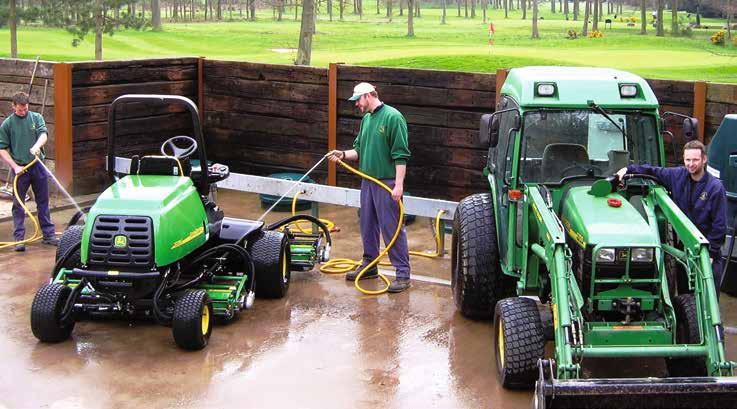


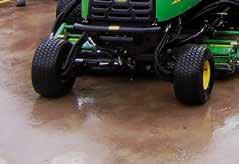







in
As the Bernhard Academy continues to develop, we spoke with the newly appointed Director of Education Craig Haldane to discuss its development.
Craig started by conveying the vision and mission of the Academy: “Our vision is simple; to be globally recognised as leaders in professionalising our industry and developing the people within it.
As a brand, Bernhard and Company is globally recognised. Now, it is about making the Bernhard Academy the same. The mission is how we achieve the vision. We forge meaningful partnerships with like-minded people and businesses who want to teach the next generation.”
Craig also emphasised the importance of differentiating between Bernhard and Company and The Bernhard Academy: “The Academy will be something completely separate from the Bernhard organisation. It will not be
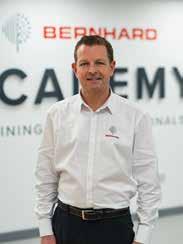
used to sell products, but intended solely for the purpose of education.”
The goal is to build the Academy to not only become a UK brand, but also go global. “We are looking at opening more facilities to give a learning opportunity to more people across the UK. We need to help youngsters to see the importance of learning information. Whether that’s through gaining NVQs or going through college. Education needs to feel like a reward. We want to link practicality and education and give people a hands-on approach.”
Craig outlined what made him want to get involved with education within the turf industry: “It is something I have always enjoyed. My interest really spiked back in 2012, when I was invited to share information in Dubai. I became passionate and empowered when

speaking about the knowledge and experiences that I have gathered throughout my career and my life.”
When discussing his own development, Craig tips his hat to mentorship: “You don’t really recognise a great mentor when you are being taught. However, you can look back and think ‘That mentor was really ahead of his time’. For example, when I was in the Middle
East, my general manager at the time was Michael Braidwood - he was a great mentor. He gave me the opportunity to develop and, if I hadn’t had those opportunities, I wouldn’t be where I am today.”
Craig brings a vast amount of experience to the Academy - from working in the scorching sun in the Middle East, to dealing with the harsh cold in his previous role
• Due to launch in Autumn.
• A series of workshops aimed at the supervisor level, management level and middle management level.
• A series of courses focused on management in a workshop environment. This will most likely run for no more than two days.
• Building some great partnerships within the industry. The aim is to get a vast amount of people who can deliver information at the Academy.
• Content on mower set-up training and sharpening techniques to be redefined and improved.
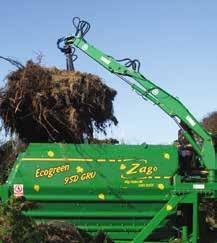
• Teaching about a positive image for the modern greenkeeper.





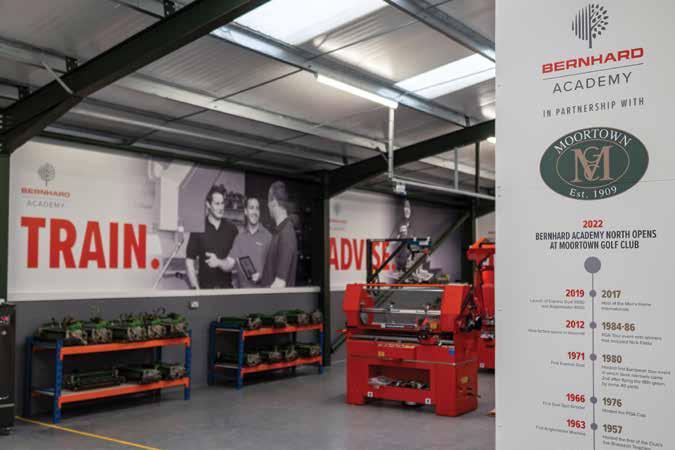
fundamentally more important as you progress through your career.”
Craig simplified why leadership and management skills need to be implemented: “Quite often, a course manager and the deputy may have both been at a course for a long period of time. Rightly so, the deputy then gets the opportunity to be promoted. He soon realises that he needs to know how to communicate with a community and how to produce a budget, plus outlining a five-year forecast and nutritional plans for the course. Both have received little training, but they now need to know what they are putting down and why - as opposed to just being told to do it.”
as Golf Courses Manager at Gleneagles. Craig highlighted how he will use his experience to help the next generation of grounds people and greenkeepers: “I went into greenkeeping with no certification in agronomy. I just did every job that was asked of me and I became obsessed with what I was doing. I needed to know more, I wanted to know more and that’s when the education aspect came into it. That’s what we will try to implement.”
Craig reflected on transitioning from working outside in the elements to working on developing the next generation of greenkeepers: “I’d be lying if I said I didn’t miss parts of the outdoor job. For twenty-six years, I managed golf courses and I love being outdoors. Although, the 4am alarm every morning is something I don’t miss so much! The transition has been smooth though and I find myself being more connected to others in the industry. I am now spending my time building relationships, as well as sharing information about the Academy and what we want to achieve.”
He draws on an analogy when explaining how he wants to interweave education and experience: “You cannot beat experience, but education behind that experience becomes
“As a new head greenkeeper, another situation suddenly put in front of you is managing other people. Learning how to get the best out of others and how to engage and develop a team. I want to build great teams, who want to come to work every day. The Bernhard Academy Leadership and Management Series will really investigate developing those communication skills to build a great work environment and culture to allow a team to thrive.”

Craig highlighted the importance of a ‘positive image’ and leading by example: “If you go into the clubhouse, take a spare change of clothes. If you go into the clubhouse with muddy shoes and kit on, people will say ‘Oh there’s the greenkeeper’. That change of attire into something smarter might change the perspective to ‘Oh that’s the course manager’. If we don’t change how we present ourselves, then people will not change their perspective on greenkeepers.”
He summarised by highlighting the importance of education: “Education is extremely important, as it forms the basis of knowledge to then be able to make decisions. I won’t suggest that without education you won’t succeed because I have met many great leaders within the industry who have not had the education, but they have a vast amount of knowledge and are successful.”
Article by James Kimmings.There needs to be a desire to learn
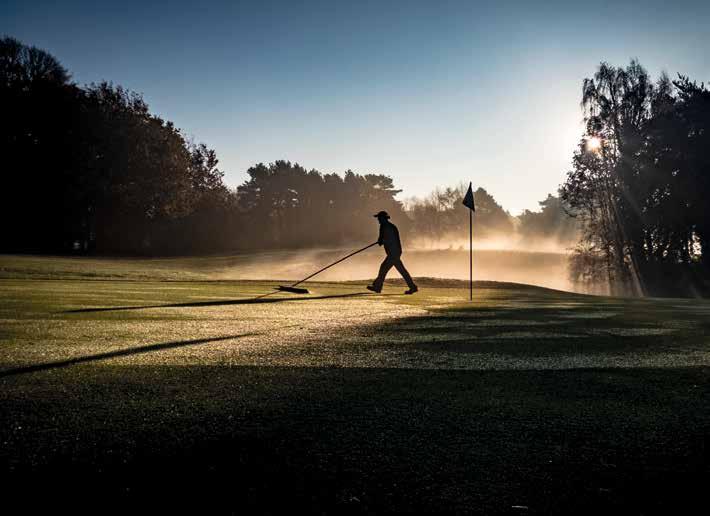















In part one of this two-part articleTrainer and conference speaker Frank Newberry explores how easy it is to put people ‘on a pedestal’. Frank is not just talking about sporting legends and war heroes who perhaps deserve special respect, but our talented colleagues and bosses are also easy to place on a pedestal.
In part 2 (in the next edition of Pitchcare), Frank will look at the ‘Abundance Mentality and the Scarcity Mindset’ which flowed from his tendency to put people on a pedestal.
Frank starts: I have to confess that I have put people on a pedestal my whole life. Always attributing qualities to them that maybe they never had. Always defending them and trusting that they:
1. were worthy of my professional respect
2. would always have my best interests at heart, and
3. would at least be sensible – most of the time.
In reality, my reasonable expectations of others were, quite often, not met at all. Bosses especially were not always very professional; they had their own best interests at heart (not mine) and they were not always sensible at work.
Yet my first instinct, then and now, is to trust people to meet my expectations, even if it involved them extending the range of talents or abilities they possessed.
A fantasy world of my own making
I was told, more than once, that I was too trusting and made too many assumptions about people. One friend said, on the question of trusting people and having positive expectations of them, that I had ‘created, and now lived in, a fantasy world of my own making’.
Now, I have been pondering this tendency for some time: Why do I put people on a pedestal? Why do I still trust people? Why do I still believe in their capacity to make valuable contributions to the work? Or to their careers? Often when the evidence is to the contrary.

Personally, I blame my mother for this state of affairs. She tended to put her father and her brother-in-law (both called Frank) on a pedestal. In her eyes they could do no wrong, and if they did do anything wrong, it was ‘understandable’ and any errors were forgiven by her immediately.
In my mother’s eyes they were totally trustworthy, and yes - both did have a highly developed sense of duty to family. For example they could, and frequently did, resolve a family member’s problems - with a good word here
One dictionary defines the practice as putting others in ‘a position of being revered, honoured, or thought of as perfect due to blind devotion’.
and, just like my mother before me, I put both would also put my school teachers on pedestals because they were better than me and, if they ever made mistakes, I was understanding and close and realised that I had been discounting
I wonder if it is just me? Maybe you are a little In part two of this article (July/August 2023),
© 2023 Frank Newberry.
If you have any questions about communication, management or problem solving please get in touch at: franknewberry. com













































Attraxor
Shown to e ectively regulate growth of managed amenity turf

£316.65
MAPP no. 18939
AI: 100 g/kg prohexadione
Primo Maxx II
Aids to divert plant growth downward into the root system to produce increased food reserves and lateral stem development.
From £264.50
MAPP no. 17509
AI: 116.4 g/l trinexapac-ethyl
QGreen Solutions 18-9-9

Highly miscible liquid fertiliser with fully biodegradable organic complexing agents, humic acids, seaweed and trace element package


From £47.80
Highly with fu comple seawee packag £
ICL Greenmaster Spring & Summer 12-4-6
ICL G Sum
Direct and e ective way of giving the grass plant the right nourishment at the right time.


From £62.60
Direct a t nourish £
BioMass Sugar
A unique natural formulation of sugars, macro nutrients, and trace elements, approved as a bio-stimulant within the UK.
£82.15 per 10l
Seaweed
Helps maintain turf in good condition and stimulate active soil microbes. Ideal turf tonic to reinvigorate turf after periods of stress.

£42.50 per 5l
From £57.65
CC Renovator Grass Seed

£96.60 per 20 kg
Absolute Premier Pre Seed 6-9-6
Suitable for turf surfaces with a cutting height greater than 6 mm, including outfields sports pitches and lawns.
£26.50 per 20 kg
Humimax
A highly e cient enhanced foliar absorption formulation, created specially for tank mixing. £80.00 per 5l



Simple to use, dual purpose implement for use on small fine turf areas.
£775.00 each















